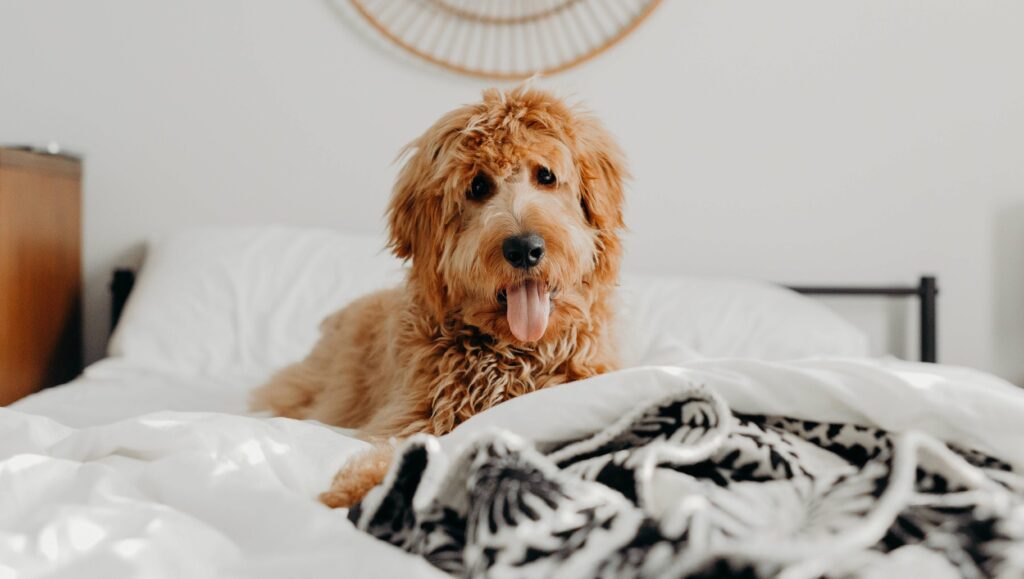
We all love our pets, and sometimes it simply seems far too difficult being apart for just a few hours, even at night. Surveys have shown that up to two thirds of people with cats or dogs now sharing a bed with their furry friend, so it’s clear that the prospect of snuggling up with the cat or dog at bedtime can sometimes be impossible to resist. Many pet owners would agree that co-sleeping with a beloved pet seems harmless. However, with sharing the bed also comes drawbacks. First of all, though, let’s talk about the main benefits of letting your pet sleep on the bed.
Benefits of Sharing a Bed with Your Pet
Bonding
Sleeping with your pet can be a great bonding experience for both parties. Dogs and cats provide their owners with physical comfort and support, strengthening your bond and relationship, which can help your pet to feel more at home.
Security
For dog owners in particular, sharing your bed with your pet every night can be a great security measure if you have any concerns about break ins. Regardless of how your dog would react to any intruders, they’re a great deterrent to any burglars and provide you with a sense of safety at night. Although your cat might not be able to put up much of a fight against any intruders, they’re highly sensitive creatures and can alert you of anything that appears suspicious, such as unusual smells or sounds.
Reduces Stress and Anxiety
Studies show that co-sleeping with your pet can help elevate your mood and reduce stress and anxiety levels. When you cuddle with your dog or cat, having that contact releases the happy hormone of oxytocin. Reduced levels of stress and anxiety levels may also help you to get a better night’s sleep.
Personal Alarm Clock
Like humans, cats and dogs sleep at night and are awake for the day (well, for the most part!). They’re both creatures of habit and love routine so don’t be surprised if you get a very personal wakeup call from your pet at 6am every morning. Look on the bright side though, you might never have to set an alarm for work ever again!
Drawbacks of Sharing a Bed with Your Pet
Fleas and Parasites
Unfortunately, cats and dogs are notorious for fleas. If you regularly welcome your pet into bed for a snuggle at night, then you may also be welcoming their fleas too. Although easily treated, having fleas is an unpleasant experience for both you and your pets. More worryingly, co-sleeping with your pet could actually be putting your health at risk. Both dogs and cats can spread parasites such as tapeworm, that can make us sick.
Hair!
If your cat or dog is prone to shedding, then don’t expect your bed to escape from the mess! It’s no secret to most pet owners how much of a nightmare it can be to forever be hoovering up your dog or cat’s fur from around the house, so if you don’t fancy adding another chore to the list then maybe it’s best to avoid sleeping with a dog or cat.
Allergies
It’s not a good idea to share the bed with your pet if you suffer from allergies, even if they’re not pet related. Those who suffer from asthma or are sensitive to pollen and dust for example, may find their allergies being triggered from sharing the bed with a dog or cat.
Behavioral Problems
When you allow your animals to share the bed, you run the risk of facing behavioral problems. For dogs that are prone to separation anxiety or territorial aggression, allowing them to sleep on the bed at night could only be worsening these issues. Cats can also suffer from issues such as territorial behavior, so if you’re met with a hiss or lash out from your cat when you attempt to move them off the bed then it’s probably not a great idea to continue sharing.
If you (or your pet) do decide to sleep alone, it’s important to make sure that you provide them with a safe and cozy bed at night. Omlet stock a wide range of pet beds for dogs and cats that optimize comfort and hygiene, so that your cat or dog will be just as snug in their own space.
If you (or your pet) do decide to sleep alone, it’s important to make sure that you provide them with a safe and cozy bed at night. Omlet stock a wide range of pet beds for dogs and cats that optimize comfort and hygiene, so that your cat or dog will be just as snug in their own space. The new Maya Donut Cat Bed offers first class comfort, made with a luxurious faux fur fabric your cat will love. Or how about trying the Topology Luxury Dog Bed for your pet pooch. With a memory foam mattress base, your dog will be in their element with a number of customizable toppers to fit their personality.
So, as amazing as it can be to share the bed with our favorite furry friends, with risks such as behavioral issues and allergies to consider, the decision really is a matter of personal choice. Either way, it’s always worth investing in your pet’s own bed to give them the option to have their own safe space (however little or often it may be used!).
This entry was posted in Dogs
Every cat owner knows the feeling of treating their feline friend to a new bed, only for him to reject it in favor of the cardboard box it came in, or even worse, jump straight back on to your bed and curl up right in the middle! But why is it that cats often like to sleep on our beds instead of their own? And can their minds be changed?
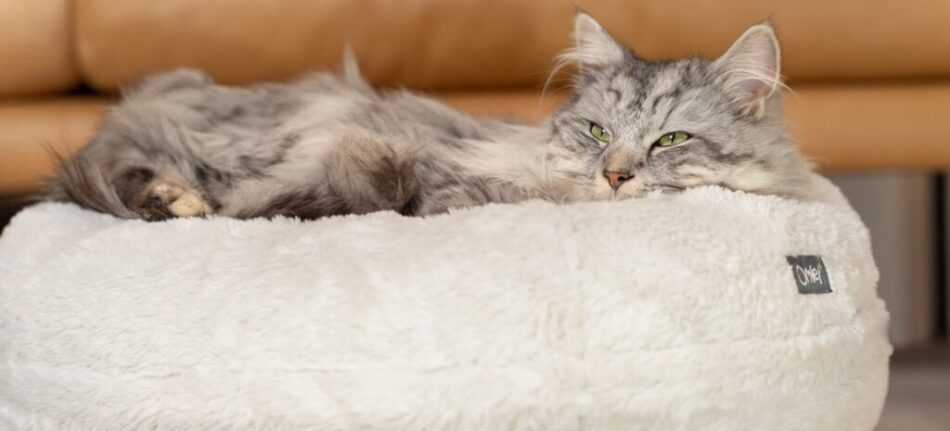
How long do cats sleep for?
Cats sleep an average of 12 to 16 hours a day! That’s double a human’s recommended sleep time. It’s no wonder cats can be so particular about where they choose to rest and can be found sleeping in different places all around the home, often depending on the time of day or night. Their important sleep routine should be supported by the perfect bed, so why do they choose yours?
Why does my cat prefer to sleep in my bed?
Many surveys have concluded that owners who allow their cat to sleep in the bed with them have a worse night’s sleep due to having less space or being disturbed by their cat meowing, snoring, purring or grooming, yet cats don’t seem to mind bunking with their owners!
You may also notice your cat is getting more use out of your bed than you and chooses to curl up there for a quick cat nap, or even a leisurely 5-hour snooze. This also leads to many cat owners reporting they have to wash their bed sheets more often if they share the bed with their cat.
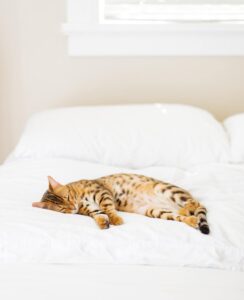 Cats may like to sleep with their owner for warmth, company or reassurance, but it may also simply be because your bed is far better than theirs.
Cats may like to sleep with their owner for warmth, company or reassurance, but it may also simply be because your bed is far better than theirs.
Why won’t my cat sleep in its own bed?
A commonly cited reason for cat owners not buying their cat a bed is that they think they won’t use it, but never giving your pet the chance to find somewhere else cozy to sleep will surely mean a life of nighttime disturbances for you.
It’s no secret that cats are the fussier pet in the home. This fussiness might extend to wanting a particular brand of cat food or litter, and of course refusing to sleep in that luxurious new cat bed you treated them too.
But why is this?
If your cat is eager to curl up on your thick fluffy blankets, or stretch out on your own memory foam mattress, the problem could lie with the quality and style of the bed you have chosen for your cat. Do you need to get your cat a new bed?
Image by Paul Hanaoka from Unsplah
Which cat bed is right for my cat?
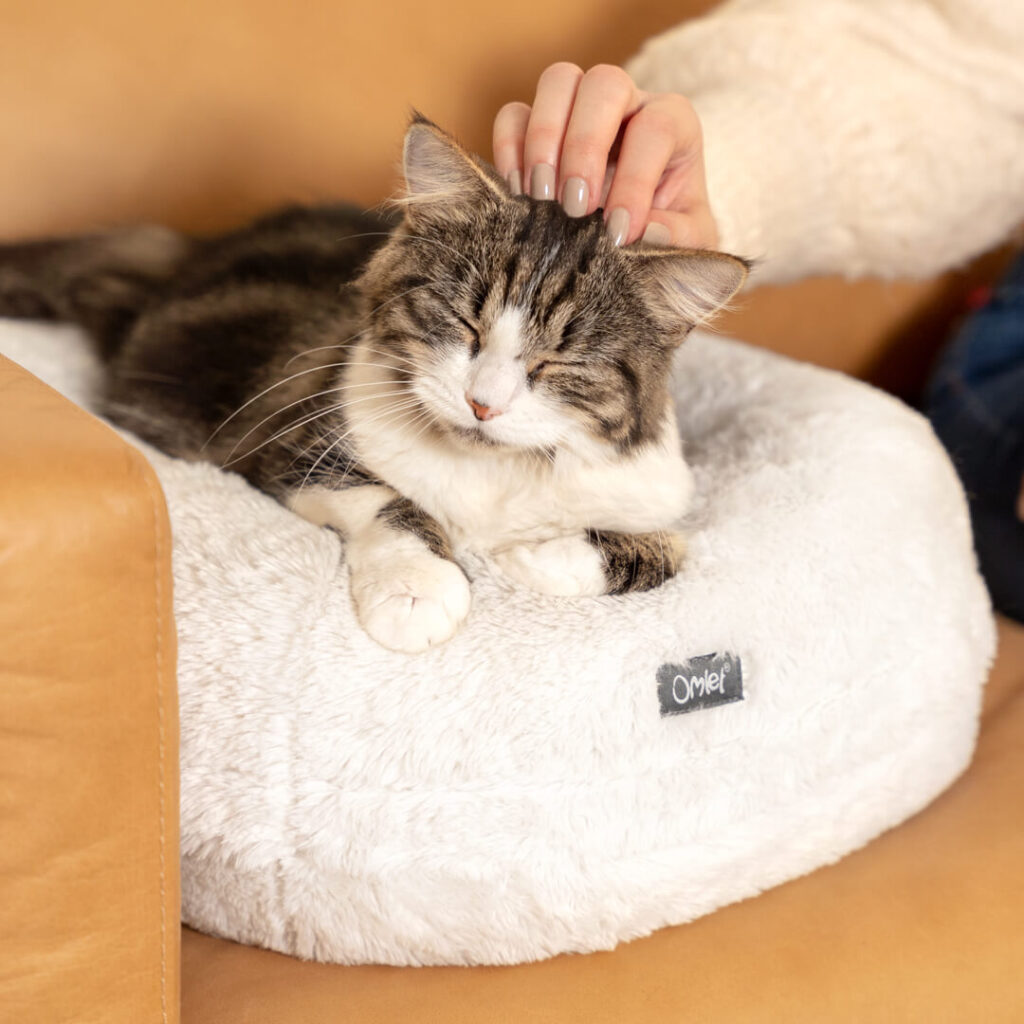 The first step to finding a bed your cat will actually use is identifying what they like; there is no use in buying a small cave bed if your cat prefers to stretch out across the sofa, or a thin, flat bed if your cat likes to sleep in a deep, squishy cushion. Ignore novelty cushions, get your cat a bed they will actually love.
The first step to finding a bed your cat will actually use is identifying what they like; there is no use in buying a small cave bed if your cat prefers to stretch out across the sofa, or a thin, flat bed if your cat likes to sleep in a deep, squishy cushion. Ignore novelty cushions, get your cat a bed they will actually love.
If your cat likes to curl up and sleep on a plush or faux fur blanket on the sofa, consider a fluffy bed they can really sink into, like the new Maya Donut Cat Bed from Omlet. The removable, machine washable cover is super soft to touch, and the deep donut cushioning supports all around the body for a warm and cuddly feeling which will lull your cat to sleep.
If your cat likes to sleep near you, place the Maya Donut Bed on the sofa for a cozy cat cushion. You can also raise the bed off the floor with sophisticated, designer feet to minimize drafts, disturbances, and maximize style.
For cats who like sleeping on their owners thick, memory foam mattress, consider a memory foam bed they can call their own, like the Omlet Bolster Bed. The generous size of the bed will allow your cat to stretch out and roll around just as much as on your nice double bed, and they can still curl up against the cushion of the bolster edge.
How can I encourage my cat to sleep in its own bed?
The position you have placed the bed in the home may also be unfavorable for your cat. Notice where your cat chooses to sleep in the day and place the bed near this area. If your cat sleeps on your bed or the sofa, start by placing the cat bed on top of these.
Use treats as a reward for getting on the bed voluntarily. Make sure not to move the bed repeatedly around the home, this could unnerve your cat and make him resistant to getting too close for fear of it being moved away again!
Some cats don’t like sleeping on the ground, so consider raising the bed up with feet, like for the Maya Donut Bed. You can also place the bed in a sleek frame, like the Maya Sofa, perfect for the Bolster Bed.
Why has my cat discarded his old bed?
If your cat has decided his once favorite cat bed is no longer for him, it could simply be a small personality change. If he’s not showing any other signs of abnormality which could hint to a health problem, he could simply have got bored of the bed, or found a better sleeping spot somewhere else in your home.
It could also be that the bed has lost its cushioning and is simply no longer comfortable enough for your cat to sleep on, or perhaps the bed has become dirty or smelly and your cat would prefer a fresh start. This also might be the case if you’ve got another cat in the home who has stolen the other cat’s best nap spot.
Make sure to buy a bed with an easy to remove and machine washable cover so you can keep the bed fresh, and a high-quality mattress or cushion which won’t lose its plumpness!
It’s important to give your cat freedom to sleep where he or she feels most comfortable, and if that’s a cardboard box then so be it! But by ensuring your cat has at least one warm and cozy option and using positive encouragement, your cat might see the benefit to his own space and finally let you sleep in peace!
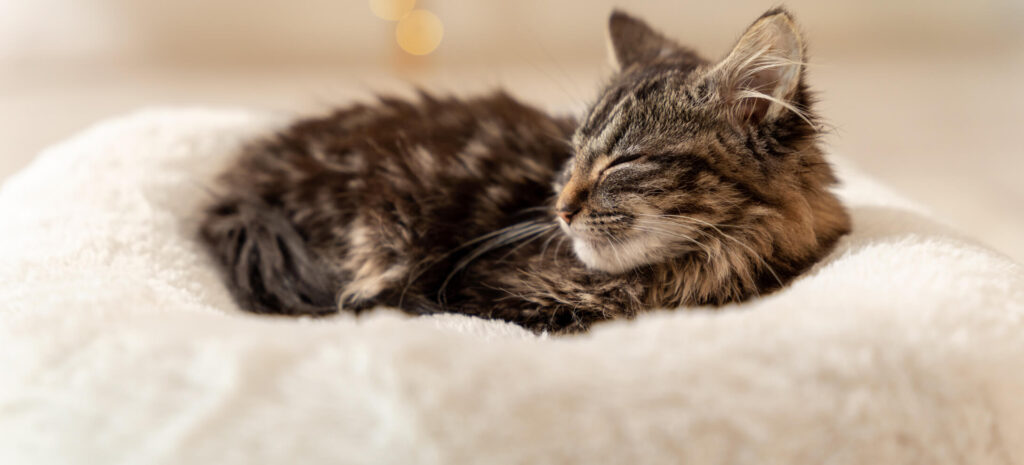
Introducing the new Maya Donut Cat Bed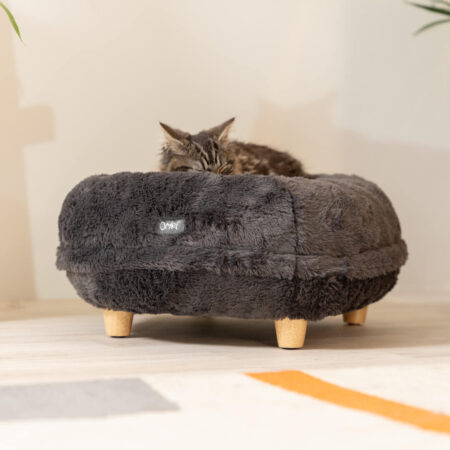
- Super soft and luxurious feel for a restful cat nap
- Removable, machine washable cover is easy to keep clean
- Raise the bed with designer feet for style, comfort and hygiene
- Supportive shape with deep filling for a warm, cuddly feeling
- Choose from two stylish colors to suit your home
- One size suitable for cats up to 11 lbs.
- Available from $28 now!
⭐⭐⭐⭐⭐ Gemma, Verified Omlet Product Tester – “I am so glad I have finally found a cat bed that is not only nice to look at but my cats love! I find that cheaper cat beds lose their shape and color quickly, and this hasn’t happened at all! It still looks great, and a super easy to wash cover means it will stay looking great for a while yet! Can’t recommend enough!”
Buy your cat’s dream bed now
This entry was posted in Cats


Topology Dog Beds give all dog’s that ‘clean sheet’ feeling.
It is estimated that 44% of Americans share a home with their canine companions but 1 in 20 of those dog owners never wash their dog’s bedding. A recent survey discovered that 22% of dog owners think that the dog bed takes 2 weeks to become unhygienic, yet 23% still leave it a month between washes! No wonder a dog bed is one of the 10 dirtiest spots in the home.
We’re known as a nation of dog lovers, but it has become clear that many owners do not give their dogs the sleeping experience they deserve. In fact, the survey showed that only half of dog owners wash their dog’s bed as frequently as dog and hygiene experts recommend: at least every other week.
The survey found the main reasons people struggle to keep their dog’s bed clean is that it’s time consuming and it leaves their dog without a bed while the cover is being washed and dried.
So how do we make it easier for the owners, and more comfortable and hygienic for the dogs? Enter Omlet’s newest innovation: Topology, the dog bed evolution our pets have been craving!
Topology Dog Beds feature patented, machine washable toppers that easily zip on and off a sturdy and supportive memory foam mattress. This allows owners to quickly swap to a new topper when the dirty one is in the wash. A range of designs from luxurious sheepskin to highly absorbent microfiber and even a beanbag version mean that you can find a topper that suits your dog perfectly, and looks great in your home.
After many days of rigorous play and nights of deep sleep, a worn topper can also be replaced without the need to throw away the rest of the bed. Economical, hygienic and kinder to the environment!
Another exciting feature of the Topology Dog Bed is the possibility to raise the bed with stylish designer feet. Not only does this make the bed blend beautifully in with the rest of your furniture, it also improves airflow around the bed without creating nasty drafts, minimizing dust and debris as well as unwelcome disturbances. Yet another improvement to dog bed hygiene, thanks to Omlet!
Omlet’s Head of Product Design, Simon Nicholls, says: “We wanted to combine all the things dogs and their owners find important into one ultimate dog bed, and what we ended up with was Topology. The combination of the base, the toppers and the feet provides extreme comfort and support, cleanliness and hygiene, and durability. It’s been really nice to see how different dogs tend to go for different toppers and how their favorites match their personalities!”
This entry was posted in Dogs
Meet five “pawsome” stars from our exciting new video, and find out more about their new favorite dog bed: Topology!
Topology is a super stylish, comfortable and practical bed that both dogs and owners will love! Machine washable toppers zip on and off the supportive memory foam mattress, so that your dog’s bed can easily be kept clean and hygienic. The range of five different toppers also means that you will be able to customize the bed to fit your dog and their personality.
We asked five of the canine characters in the Topology video to tell us which topper was their favorite and why:
Freddie love his Topology Dog Bed with a comfy Beanbag topper
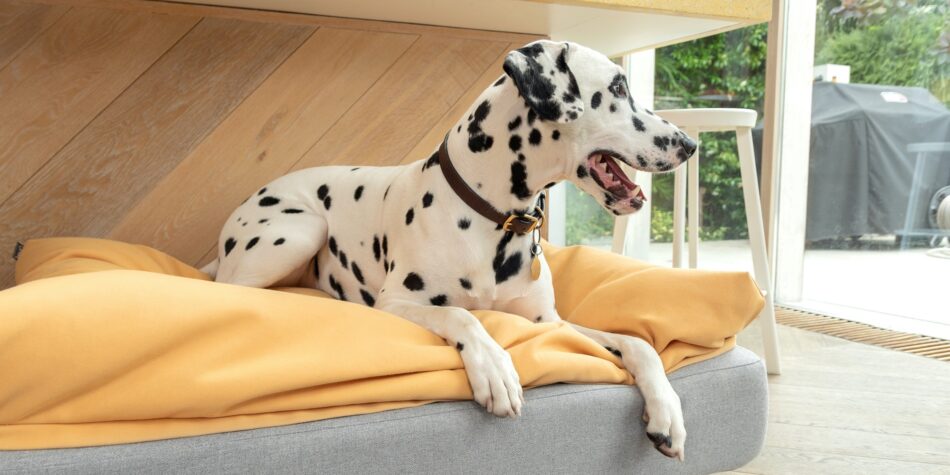
Freddie is a boisterous Dalmatian with bundles of energy! He loves showing off his jumping skills, and will happily throw himself at his bed over and over again to burn off some steam. This isn’t a challenge for the robust fabric and stitching of the Topology Dog Bed, and Freddies favorite topper, the Beanbag, is both fun and super comfortable as it fully lets the dog’s body relax as they lie down on top of it.
It doesn’t happen often, but sometimes even Freddie needs a good, long nap, and as much as the Topology dog bed can withstand his lively playing, it will also provide superb support for his resting body. Thanks to the memory foam layer in the base and the softness of the topper, the owners of Freddie have no doubt he’s fully relaxed and comfortable when he finally settles in for the night.
Woody could relax for days on his Topology bed with luxurious Sheepskin topper
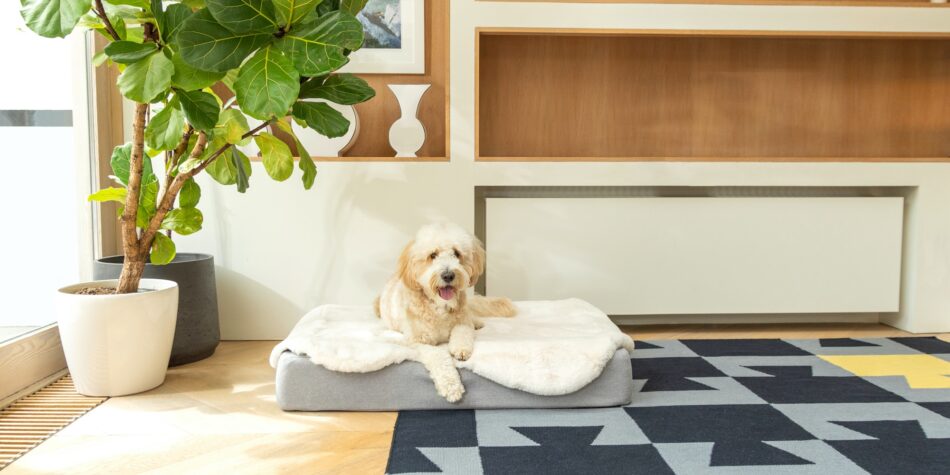
Even if neither he nor his owner would admit to it, Woody the Goldendoodle is what many would describe as a pampered pooch. He won’t settle for anything but the most luxurious of dog beds after his strolls around the city’s parks, so it’s no surprise that his favorite topper is the sheepskin.
Positioned in the best position in the living room, Woody can stretch out on his Topology Dog Bed and feel the super soft fabric against his skin while the memory foam mattress molds around his body. Woody’s owner really appreciates how easy it is to remove and clean the topper.
Winston feels safe and supported on his Topology dog bed with Bolster topper

Little Winston is a Dachshund, and only six months old. With all the exciting exploring, learning, playing and chewing shoes he has to do all day, it’s extra important that he has a comfy bed to retreat to when he gets tired.
Winston absolutely loves the bolster topper. Not only does the perfectly padded bolster give his little head support when he snoozes, it also encloses the body to provide a den-like feeling that adds a sense of security.
Margot favors the elegance and extreme comfort of the Quilted topper

Margot is a classy Afghan Hound who appreciates the simple luxuries in life. She loves being comfortable, preferably curling up by the fire after a walk around the town when she enjoys meeting new dogs to sniff.
Margot’s favorite topper is the super soft quilted version. It stays cool against the body in Summer and has a warming effect in Winter, and the classic design oozes luxury and comfort. Additionally, Margot’s owners love the look of the soft minty grey against the rest of their furniture!
Esme can dry off and relax on the Microfiber topper on her Topology Dog bed

Esme is a perfectly sized terrier mix who loves nothing more than running over wide fields and chasing squirrels between trees on long country walks. Rain and wind won’t stop her – the muddier the better! That’s why the microfiber topper is her favorite. The structured fabric is nice to roll your wet back against, and it will speed up the drying process.
Esme’s owners also love that she’s got a space to dry off after inevitable hose-downs that isn’t the living room carpet! Leftover mud and moisture from walks will quickly and smoothly blend into the microfiber topper, and it can be washed over and over again, allowing for more lovely nature walks.
This entry was posted in Dogs
It’s often hard to tell if a hen is laying. Hens do not produce the same number of eggs each week throughout the year, and there may be health- and environment-related changes to egg production, too.
It’s useful to know when a hen stops laying, as you can then give her a quick health check to identify the cause of the interruption. But how do you tell which chicken is not laying eggs? In a coop of six hens, in which the daily average number of eggs is five, it’s not immediately obvious which hens are laying.
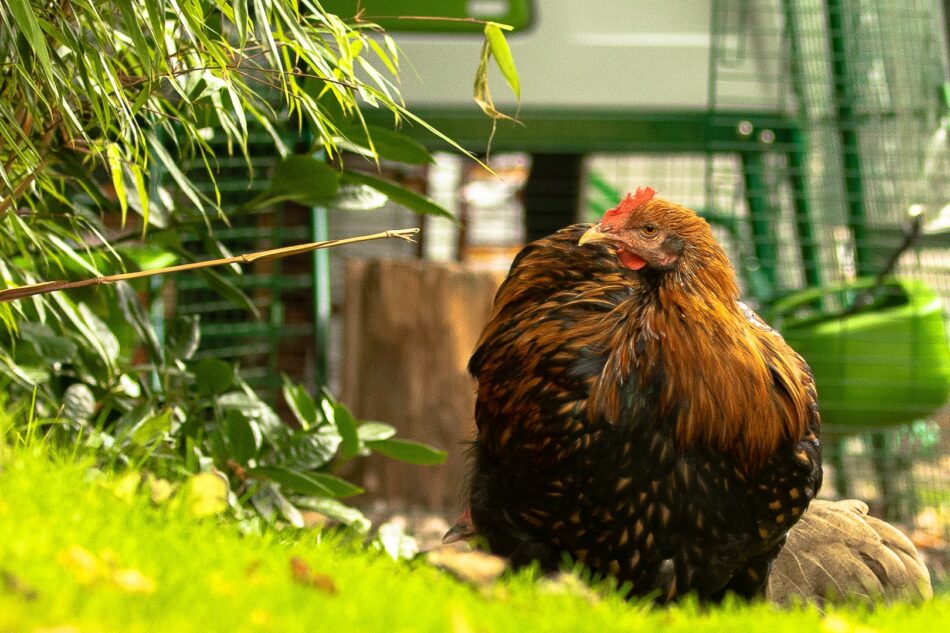
Seven signs that a hen has stopped laying
1. Age. This is the most obvious cause of a drop in egg production. Over her egg-laying years, a hen’s production will tail off. This is natural, and it does not mean the chicken has reached the end of its usefulness. All hens play a part in the social order of a coup, and a bird reaching the end of its egg-laying life will still be as feisty, active and lovable as the younger birds – and she’ll still lay the occasional egg.
2. Molting. This occurs every year once a hen is 18 months old (although younger birds may shed feathers, too). The signs are very clear – lots of feathers lying in the coop, and bare patches appearing on the hen. During this time, chickens need to produce lots of new feathers, which is a physically demanding process. Consequently, egg-laying is reduced, and sometimes there will be several days without an egg. The molt tends to occur in the autumn, but it depends on when the hen first started laying. Molting takes 8 to 12 weeks, occasionally longer.
3. Vent. A dry vent – the hole through which the hen lays her eggs – is a sign of no production. In a hen that is still laying, the vent will be moist.
4. Abdomen. Your chicken’s abdomen area should feel soft and rounded. If the area below the breast bone is hard and swollen, this can be a sign of egg peritonitis, a bacterial infection in the chest cavity. Your chicken will still produce a yolk but is free-floating in the abdominal cavity. Affected hens will stop therefore either completely stop laying eggs or only lay soft-shelled, thin, or misshapen eggs.
5. Comb and wattles. A healthy laying hen tends to have bright red comb and wattles. These become duller when she is about to lay, but turn bright red again once she has laid the egg. If the comb and wattles are pale or dull looking all the time, it could be a sign of illness.
6. The food dye test. If you put a small dab of food coloring on a hen’s vent, the color will be transferred to the egg. The color that fails to appear tells you who the non-layer is. This is only practical in smaller flocks, though, given the limited palette of food colorings…
7. No eggs. This isn’t as silly as it sounds! If you only have a few hens, and they are different breeds, you will often come to recognize which eggs are produced by which hen. In this case, the sudden disappearance of one particular egg-type will tell you who’s not laying.
Five reasons why hens stop laying eggs
1. Temperature and sunlight. Seasonal factors play a part in egg production. As the daylight hours lessen in autumn and winter, hens tend to lay fewer eggs. In the depths of winter, the low temperature becomes the cause, as a hen needs all her energy to produce body heat. With her resources diverted to this essential function, egg-laying is put on hold.
2. Stress. Any form of stress will tend to interrupt or stop egg production. Stress can be brought on by several things, including parasites, bullying, injuries and fear (of noisy dogs, for example).
3. Diet. Poor diet can impact egg production, too. If a hen is laying, she needs all the essential nutrients – not just calcium – to produce eggs. Top-quality layer’s pellets will contain everything the hen needs. A hen that fills up on treats before filling up on pellets may become malnourished and stop laying. It’s a good idea to let the chickens feed on their pellets first thing in the morning and last thing at night, and only offer corn and treats in the middle of the day.
4. Broodiness. A broody hen – that is, a hen who has decided to sit on her eggs in an attempt to hatch them – will stop laying. There are several ways of discouraging broodiness, but some hen breeds are more prone to it than others. If all attempts to dissuade her from leaving the nesting box, you have the consolation that after 21 days – the time it would take for a fertilized chicken egg to hatch – the hen’s self-inflicted ordeal will be over and she will resume normal life – including egg-laying.
5. Change of routine. If you move the hen house or introduce new birds to the flock, or if one of the hens dies, the birds’ routine and pecking order will be interrupted. This often causes them to stop laying for a short time, until their social lives settle down again.
Four ways to encouraging laying
1. Comfy coop. The first thing to do is to make sure the hens’ environment is adequately equipped and comfortable. Check for red mites, as an infestation of these nocturnal parasites can stop egg production. Reduce drafts and make sure there is no bullying going on – often a sign of an overcrowded hen house.
2. Light. Some chicken keepers install lights in the coop to encourage laying in the colder months of the year. However, bear in mind that a chicken can only lay a finite number of eggs in its lifetime. If she’s naturally programmed to lay 1,000 eggs, encouraging her to lay regularly throughout the winter will simply reduce her laying life.
3. Eggs. If an apparently healthy hen isn’t laying, she can be encouraged by leaving eggs in the nesting box, or placing rubber ones, or even golf balls, in the spot where she is supposed to lay. The sight and feel of these will encourage her laying instincts.
4. Reduce stress. Discourage dogs from disturbing the hens, and make your run and coop are as predator-proof as possible. Equally important, make sure the run isn’t overcrowded, and provide enough roosting space in the coop for all the hens to rest comfortably.
Disappearing eggs
If your hens are free-ranging, they will sometimes lay an egg in a quiet corner of the backyard. This can become habit-forming, and if she’s doing it in secret, you may reach the incorrect conclusion that the hen isn’t laying.
A healthy hen who does not appear to be laying may be the victim of egg sabotage. A predator, a human thief or an egg-eating chicken might be removing the evidence of her labors. The best way of preventing this is to encourage your hen back to the nest box for laying. In crowded coops, a hen will sometimes seek an alternative laying place if the boxes are all full when she feels the urge to lay.
As a hen ages, she will produce fewer eggs. If you are uncertain of the age of your chickens, there is a simple test you can conduct that might sometimes give you a clue. Place your hand gently on a hen’s back. If she immediately squats down, it means she is still fertile and therefore producing eggs. Hens squat when they are mating, and it is an automatic response.
Although egg production drops as a hen ages, it will often continue throughout her life. The occasional egg from an old hen always reminds you what a wonderful friend she’s been throughout your long time together!
This entry was posted in Chickens
Photo by lilartsy on Unsplash
If you have done your research and decided that a rabbit is the pet for you, you now have the task ahead of choosing which rabbit breed you would like to get. There are lots of wonderful breeds to choose from, and they all have their own specific features and characteristics. To help you pick the right rabbit for you and your family, we’ve put together a list of things to think about:
Size
Rabbit breeds differ in size, from small Netherland Dwarfs to large Flemish Giants. Smaller breeds tend to be more skittish and nervous, whereas larger rabbits are generally more gentle and less aggressive.
Larger rabbits will naturally need more food, and more space. But don’t think that small rabbits will be fine with limited space, often littler bunnies run around a lot more as they have more energy.
Child-friendly rabbit breeds
While young children should never be given the main responsibility of looking after a rabbit, if you have children in the family it’s good to find a breed that is generally happy to be touched and handled.
A lot comes down to personality, but there are some breeds that are known to get along well with children, like French Lops and Dutch Rabbits.
Reason for getting a rabbit
Think about why you are getting a rabbit, and what is important to you in a pet. Are you happy to just watch them enjoy themselves in the garden, or would you really like to have a rabbit that is sociable and wants to come to you for cuddles? Would you like to breed for your bunny, or show it off in rabbit shows?
Looks
Rabbits come with various fur lengths, colours, ear types and builds. You probably have an idea of what you would like your pet rabbit to look like, but it’s worth exploring a few different breeds to see what’s out there.
It’s important to remember that different breeds require different amounts of grooming and looking after. Long fur, like that of the Angora rabbits, will for example need brushing daily or a few times a week, so you will need to consider if that is something you will be happy to do.
Meet the rabbit in person
While rabbit breeds have characteristic features and temperaments, a lot also comes down to breeding and personality. If possible, try to go and see the breeder or person you are buying your rabbit from, or the center where you’re adopting from.
If your rabbit is still small, watch how they interact with their surroundings and siblings, and if possible, see what the mother is like. Make sure the rabbit doesn’t have any obvious health problems, and try to get a feel for its temperament. If it’s important for you that the rabbit is happy to be picked up, make sure they have been around humans from the start and have regularly been handled.
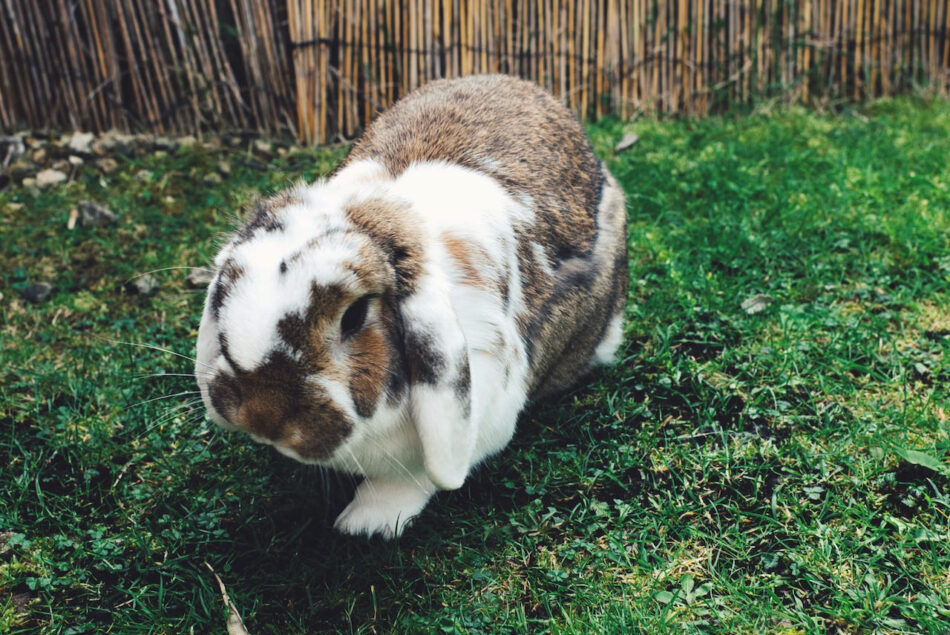
Photo by Cameron Barnes on Unsplash
Genetics
Read up on specific breeds’ susceptibility to different health problems. Some breeds tend to have a higher risk of developing problems with their jaws, others with joints, or ear mites. With good care the absolute majority of rabbits will be happy and healthy, but it’s a good idea to research problems in order to prevent them.
The expected lifespan also differs somewhat between breeds. The majority of rabbits live between 5-8 years, but some breeds are known to often live for over 10 years. This is obviously a bigger commitment, so it’s worth thinking about.
Consider these things when choosing a pet rabbit. If you know what you want, here are some of our suggestions:
You want a gentle family bunny that is good with children
You have had rabbits before and want something special
You want to keep your pet rabbit indoors
You want an intelligent rabbit that is very energetic and playful
You want a really fluffy and cuddly rabbit
This entry was posted in Pets

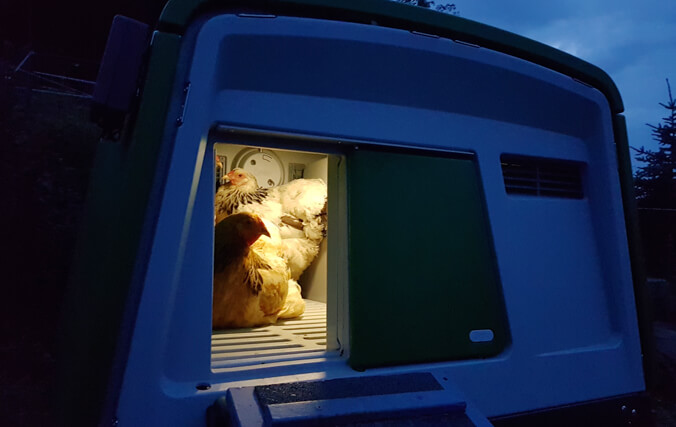
Your chickens’ coop should be a space for your flock to eat, drink, lay eggs, and sleep. It should also be a place for your chickens to feel safe and be protected from the outside elements or any danger. However, sometimes chickens may suddenly decide that they do not want to go into their coop at night, which can be for a number of reasons. Here are some explanations as to why this could be happening.
A Broody Hen
Hens can get broody, regardless of if you have a rooster. Although many hens will decide to stay in the nest of their coop so that they can sit on their eggs, others like to search for a quiet space away from the coop, which can mean remaining outside the coop all night.
Moving a broody hen can be highly stressful for them, so should you decide that it’s best to move your hen inside the coop, due to safety concerns, you need to take great care when doing so. One way to start is by collecting your hen’s eggs regularly (twice a day). Be sure to wear leather gloves when doing so, as a broody hen is likely to be aggressive around you as they are very protective of their eggs. You’ll also want to reduce the light supply when you move her, as the moving process situation will be less traumatic in the dark.
Predators
Predators such as foxes, cats, rats, and badgers could be one reason as to why your chickens have stopped going inside the coop at night. These animals will spook your flock, with smaller predators such as badgers having the potential to gain access inside the coop by climbing over the fencing, or squeezing through small openings in the coop’s wiring.
Luckily, there are a few steps you can take to deter these animals and have your chickens back in their coop every night. One option is to get a motion sensitive light installed, which will scare off any unwanted guests. Alternatively, take a look at the Omlet chicken coop range. All of the Omlet coops are predator resistant, which will reassure you that your chickens will be safe from any night time visitors. With anti-tunnel skirts that lie flat on the ground, and heavy duty steel weld mesh, these features will help to prevent animals from digging in. You can also purchase the Omlet automatic coop door which shuts your chickens away in their coop at night to keep your flock secure, enclosing them until the time you set for the door to open in the morning.
An Overcrowded Coop
Chickens need their own personal space, hence why many chickens are also kept free range. Not only is overcrowding an unpleasant experience for chickens, causing them to avoid the coop at night, it can also lead to further complications such as the build up of ammonia and an increase in disease. The solution? The more space the better! For size reference, the Omlet Large Eglu Cube chicken coop can comfortably accommodate six large hens or up to ten bantams.
Tensions Amongst Your Chickens
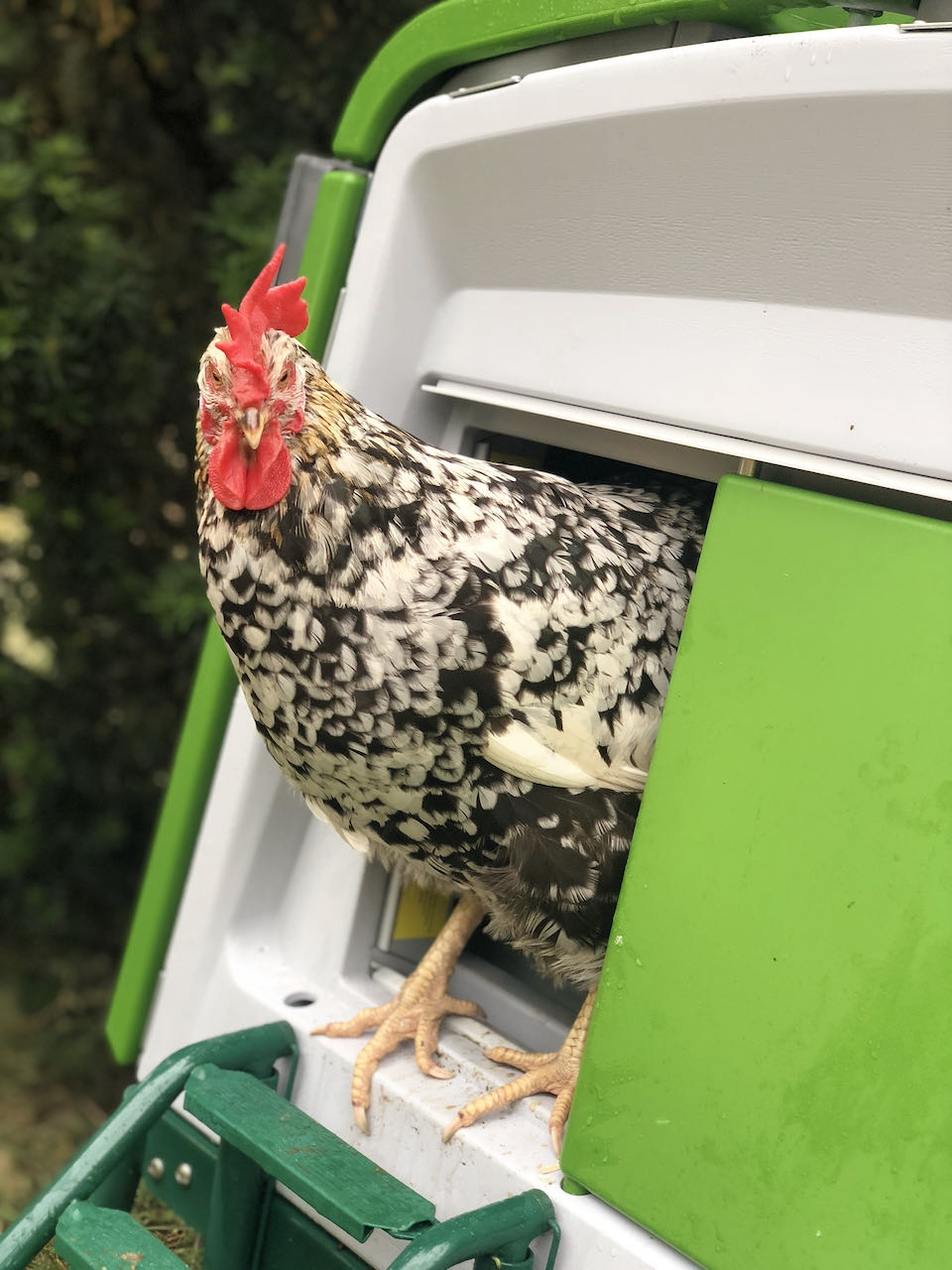 Unfortunately, bullying amongst chickens happens, and isn’t actually too uncommon of a problem. Chickens naturally create a pecking order, whereby the flock will establish themselves in a social hierarchy of strongest to weakest chicken. However, if aggressive behavior continues after the head rooster, or the dominant hen in their absence, has found their way to the top of the ladder, you may be dealing with a bully. Common signs are missing feathers from a chicken’s back, unusual weight loss, reduced egg production, or blood from where the victim has been pecked, all of which could lead to a chicken/s refusing to go into their coop at night.
Unfortunately, bullying amongst chickens happens, and isn’t actually too uncommon of a problem. Chickens naturally create a pecking order, whereby the flock will establish themselves in a social hierarchy of strongest to weakest chicken. However, if aggressive behavior continues after the head rooster, or the dominant hen in their absence, has found their way to the top of the ladder, you may be dealing with a bully. Common signs are missing feathers from a chicken’s back, unusual weight loss, reduced egg production, or blood from where the victim has been pecked, all of which could lead to a chicken/s refusing to go into their coop at night.
To stop the bullying, and therefore get your chickens back in their coop at night, first try to establish the cause. Common reasons for bullying can be an injured or ill bird, having a large flock, or your chickens being bored. However, should the bullying continue after attempting to resolve what you believe to be the cause of conflict, you can purchase anti-pecking spray, which will discourage feather pecking. Alternatively, separate the bully from the flock. Isolating the bully for a week may mean that they lose their dominant position in the hierarchy once they are reintroduced.
Mites and Parasites in the Coop
Pests are a very common cause for chickens to have stopped going to their coop at night. Red mite in particular is a likely culprit, a parasitic mite that lives inside chicken housing and lays eggs in cracks near nests. They can make your chickens restless at night, as they live inside chicken coops and crawl onto the chickens to feed on their blood as they sleep. Only active during warmer weather, red mites are also more likely to strike wooden coops.
Red mites are not the easiest thing to get rid of, however, one solution is to purchase red mite treatment, which works by immobilizing pests with its sticky consistency. Rest assured, it’s also completely safe to use in the chicken feeding area, so you do not have to have any concerns about your flock digesting the product.
Luckily, chickens are creatures of habit, so once you’ve identified the cause, you should be able to get your flock back into the coop at night in no time!
This entry was posted in Chickens
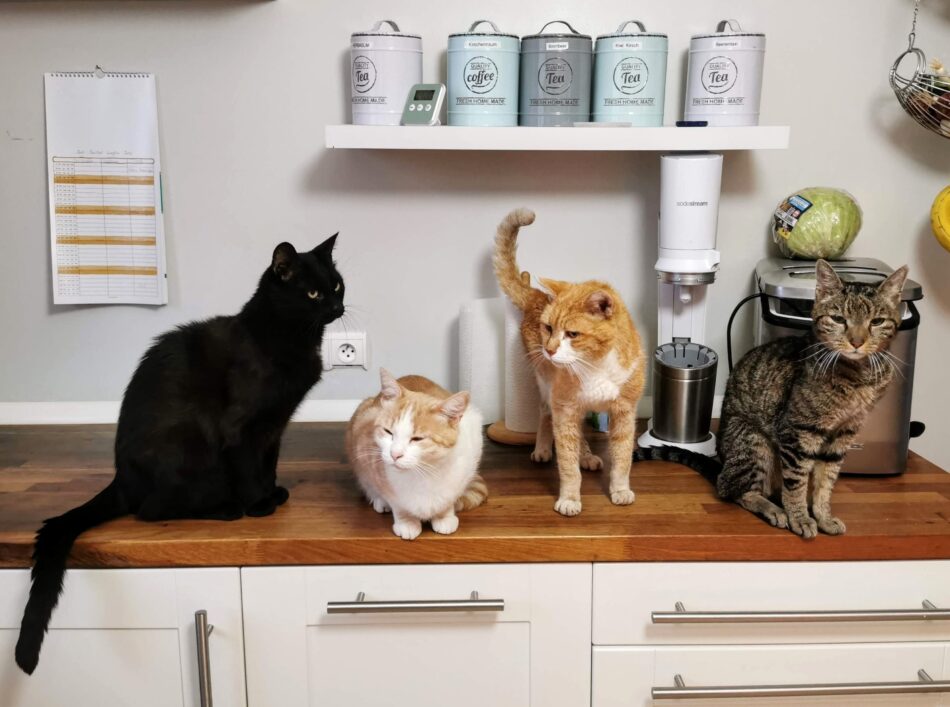
Photo by Dietmar Ludmann on Unsplash
Despite many cats enjoying being independent creatures, according to the PDSA PAW Report, 43% of cats in the UK now live in multi cat households. While it’s understandable why so many of us give in to the temptation of introducing another feline friend into the home, it’s also important to be cautious of the potential onset of cat behavioral issues such as aggressive behavior i.e. hissing, growling, or chasing as a result of doing so, and to consider if the dynamic of a multi cat household would work for you and your family. However, if you do decide to take the plunge, here are some tips on how you can try and keep the peace.
Plenty of Exercise
Providing your cats with plenty of exercise will help to keep them at a healthy weight and keep them stimulated. Both are important for all cat owners, even those who only have one cat. However, for cats who live amongst other cats, keeping active can aid with avoiding a potential buildup of excess energy, which can sometimes manifest itself as aggression towards other cats in the household.
One way to help keep your cats exercised is through play, which will also help to strengthen the bond between you and your furry friend. How about trying the new catnip wand toys that will encourage your cats to chase and provide them with endless hours of fun. Another great way of exercising your pets is to invest in a cat tree. Cats love climbing and scratching, so a cat tree is one sure way to encourage this and keep them entertained.
Use Pheromone Diffusers
Pheromone diffusers are an odorless plug-in product that works by producing pheromones, or chemical substances, that your cat naturally releases when they either rub against surfaces, scratch at items, bump heads with humans or other cats, or spray. Pheromone products mimic how pheromones would naturally send messages between cats, meaning that they can help in multi cat households to have your cats to feel more relaxed, and reduce their stress levels.
Multiple Litter Boxes
It’s important that your cats have their own litter box when they live with other cats. This is because of their territorial nature, which often means that cats like to ‘claim’ where they go to the bathroom and do not like this area to be shared. If cats feel as though their territory is under threat, this can lead to aggressive behavior such as fighting.
Furthermore, most cats will refuse to use a dirty litter box, which will likely happen should you only provide a single litter box for several cats, as of course, their waste will accumulate more quickly than if your cats were to have their own. The general rule of thumb is that you should have one litter box per cat, plus one spare to have placed out in your home.
Separate Feeding Stations
Cats like to be alone when they’re eating, meaning that if you have multiple cats, they will require separate feeding stations at mealtimes. When cats are forced to share the same area for feeding time with another cat, it can take away from their predatory instinct to hunt and eat by themselves, which inevitably can induce anxiety and aggressive behavior. In a multiple cat home, cats may see a shared feeding area as an opportunity to compete for food, which could result in you having a ‘food bully’ on your hands. As well as providing your cats with their own food bowls, give them each a designated space in the home to eat any from any other cats.
Furthermore, creating this divide will help your cats to stay healthy by having them fed equally, or in accordance with their own specific dietary needs, as it ensures one cat cannot access the other’s food. For example, factors such as the age, weight, or medical condition of your cat/s may mean that they have to be fed different diets. Therefore, it’s fundamental that you leave each cat’s bowl out of reach from any potential cat food thieves!
Personal Space
By nature, many cats need their own personal space, even when they’re not eating. It’s a good idea to have an area in the home that they can go to escape to by themselves, away from both humans and other animals. If you have the room, it’s advisable that each of your pets have at least one of their own private areas in the home that they can go to without being disturbed and becoming overwhelmed. This may even be a cardboard box if you’re limited for space but be sure this is away from the hustle and bustle of the home or outside.
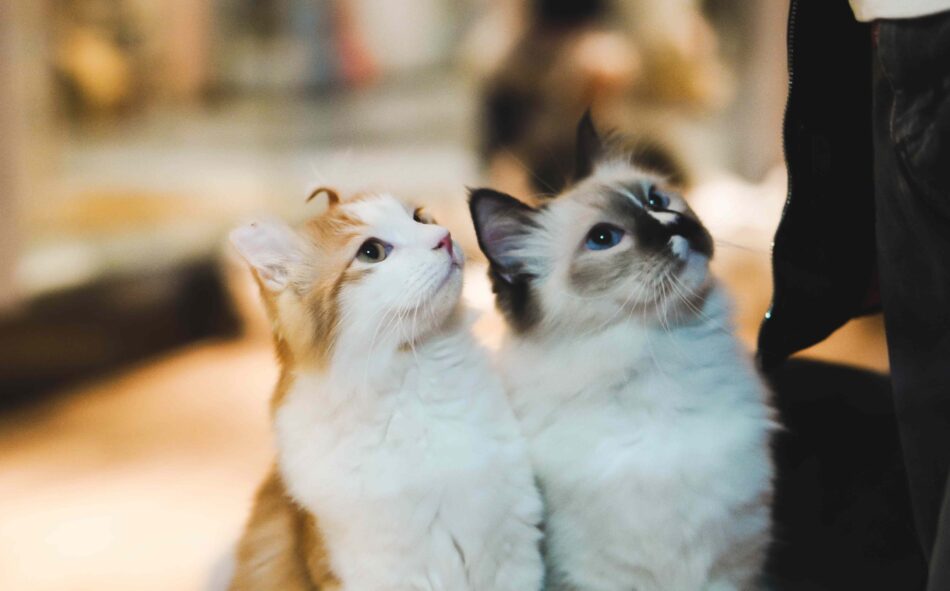
Photo by Kelly on Unsplash
Introducing a new cat can be a difficult time for you and your already existing pet, but fortunately, it’s not impossible to make multi cat households work. So, after a bit of advice, hopefully the transition period will be a lot easier. However, should you notice any signs of aggression between your cats, it’s important to seek help from a veterinarian before these issues get out of control.
This entry was posted in Cats
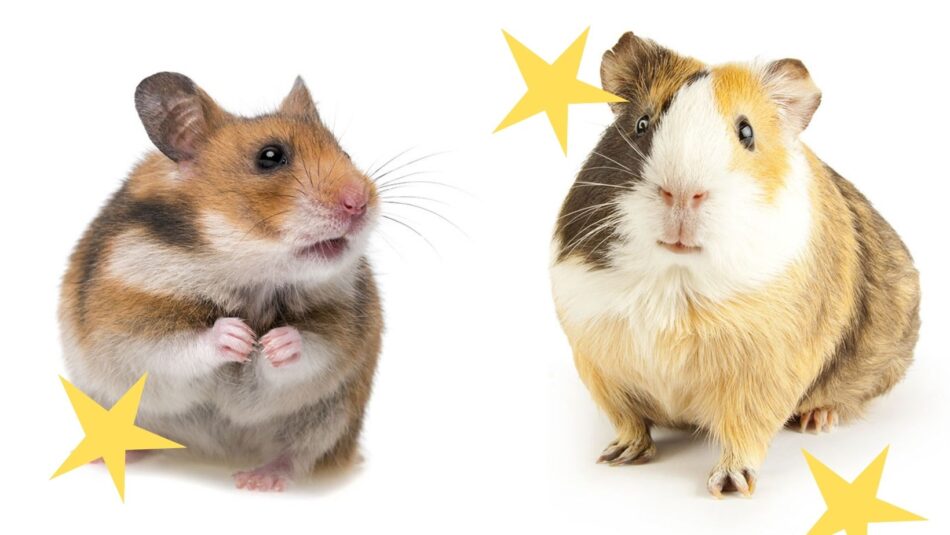
Hamsters and guinea pigs are relatively low maintenance pets that make a great choice for new pet owners. The two animals have several fundamental differences, though. Knowing what these differences are will help you make the right choice when choosing your pet.
Wild hamsters live across large areas of Europe and Asia, notably in Syria, China and Russia, which are the ancestral homes of most hamsters kept today as pets. These little rodents prefer dry, warm climates.
Guinea pigs are native to the mountainous regions of South America – Colombia, Ecuador, Peru and Bolivia. However, they belong to the same broad family as hamsters – the rodents. This kinship is a bit misleading, though, as the animals have distinctly different needs and dietary requirements.
Hamster vs Guinea Pig
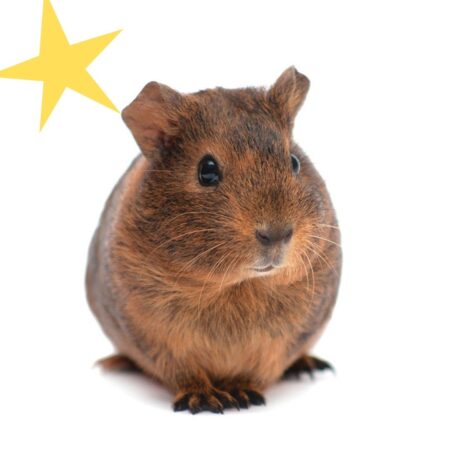 While these two critters do have things in common, their different habitats and ways of life mean that a hamster’s home setup is very different from that of a guinea pig.
While these two critters do have things in common, their different habitats and ways of life mean that a hamster’s home setup is very different from that of a guinea pig.
One major thing that differentiates hamsters and guinea pigs is lifespan. Hamsters have shorter lifespans than guinea pigs, generally living for 2 to 4 years. This is because they are small and have metabolisms that work much faster than their guinea pig cousins. Guineas generally live from 5 to 8 years, with some individuals reaching 10 years.
Another key difference between the two is their size. As we mentioned above, hamsters are much smaller than guinea pigs, with the average size being in the region of 5-15cm. Even the smallest guinea pigs are larger than the biggest hamsters, with the average guinea being 20-30cm long. This means that guinea pigs need larger enclosures.
While the size of the animal and its enclosure needs to be considered, these factors don’t have a huge impact on general pet care. The following differences are the ones that need to influence your decision.
The four main differences between hamsters and guinea pigs
1. Sleeping patterns
This is possibly the biggest difference between the two species. Hamsters are generally nocturnal creatures, which means they prefer the nightlife. Many hamster owners will be able to tell you how their hamster starts running in its squeaky wheel at 1am!
Guinea pigs, on the other hand, are mostly active during the day, taking naps whenever they feel the need. Rather than sleeping for one long spell each day, they recharge their batteries whenever they feel like it. They do tend to sleep more during the night, though.
2. Social needs
Hamsters and guinea pigs have completely different social needs. In the wild, guinea pigs live in groups of three to ten individuals. They have evolved to be social animals and will soon become sad and stressed if they are denied this interaction. Lonely guinea pigs have even been known to die when left in isolation for too long.
For this reason, it is highly recommended that owners should keep at least two guinea pigs. Keeping just one can work as long as someone is willing and able to step in and do the socializing. Because of their need to be with other animals, guinea pigs will be much more willing than hamsters to spend time, play and interact with humans. This factor – and their handy habit of sleeping at night – can make them the superior choice for children who want to play with their pets.
Hamsters are loners. That, at least, is the case with the Syrian or Golden hamster, which is by far the most popular pet hamster species. While they can live with companions, the other hamster species are perfectly happy – and may in fact be even happier – living on their own. Many hamsters that are kept together can become aggressive towards one another, especially if two males are being kept in close quarters.
If looked after properly and hand-tamed from an early age, hamsters will form a bond with their owners and will be glad to spend time with them. An unsocialized hamster will often bite, though, and this is another off-putting thing for children.
3. Diet
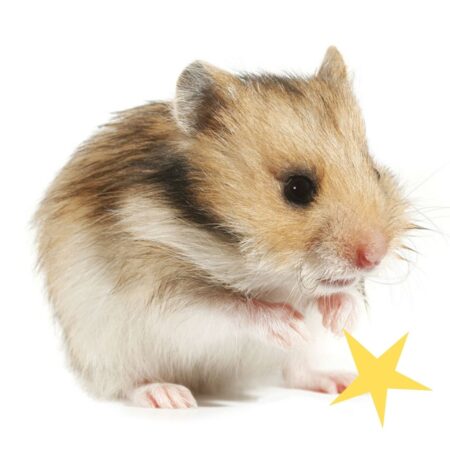 The dietary requirements of hamsters and guinea pigs are probably the most significant difference between the two species. Hamsters are omnivorous and will eat pretty much anything they can find. They famously store food in their cheeks for later, making their cute faces puff up, almost doubling the animal’s size.
The dietary requirements of hamsters and guinea pigs are probably the most significant difference between the two species. Hamsters are omnivorous and will eat pretty much anything they can find. They famously store food in their cheeks for later, making their cute faces puff up, almost doubling the animal’s size.
The easiest option for feeding a hamster is to buy a pre-made food mix that has all the things they need, rather than sourcing your own insects and extra protein to supplement the plants and vegetables in their diets. You can feed your hamster fresh fruit and vegetables, as long as they are washed, and as long as they don’t completely replace the hamster mix. Grains and cereals make a good addition to their diets, too. Also, be sure to provide your hamster with something to chew on, such as a piece of wood or some straw, as this helps keep their teeth in check.
Unlike hamsters, guinea pigs are vegetarian. In the wild, they eat fruits, plant roots and – most importantly – lots of high-fibre grasses. As with hamsters, domestic guinea pigs should be fed a specially made food mix. However, these often have lots of carbohydrates and not enough fibre. For this reason, your guinea pigs will also need lots of fresh vegetables, fruits, grass and hay alongside their food mixes. Hay is crucial for keeping the guinea pigs’ teeth in check, and it also ensures a healthy balance in the stomach bacteria the animals need for digesting their food efficiently.
4. Space
Hamsters are always kept indoors, as they need to be kept somewhere consistently warm. Being small creatures, they don’t need a huge amount of living space, and an enclosure such as the Qute can be incorporated into a room as an attractive part of the furniture as long as they are taken out of the cage for daily exercise and play.
Guinea pigs, in contrast, need a larger hutch and a run, as they are not only bigger than hamsters but need to be kept in groups. Some are kept indoors throughout the year, but if you have space for a guinea pig run in the garden, the animals will love it, and children will be able to interact with their pets in the most effective way.
The upshot here is that a hamster can be easily accommodated if you only have a small indoor space, but a guinea pig can’t.
Overall, both hamsters and guinea pigs make great pets, and both are low maintenance. The key differences between the two are size, lifespan and diet. When choosing which of these wonderful little animals to keep, it mainly boils down to personal preference. As long as you care for them properly, they will soon form a close bond with you.
This entry was posted in Guinea Pigs

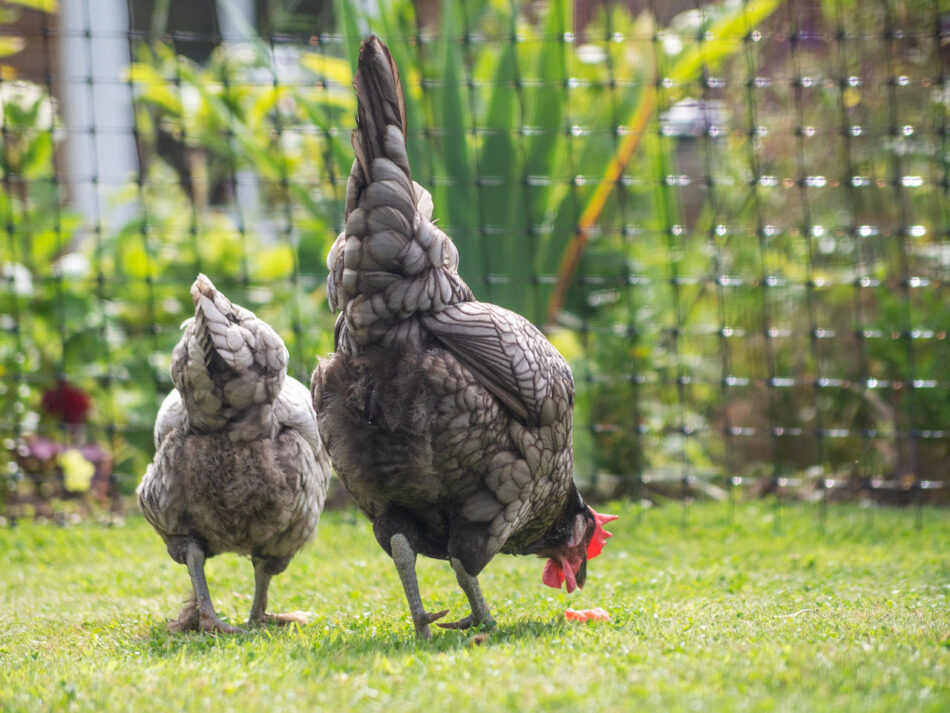 As the days get shorter, you might find that your chickens are not laying as much as they normally do. Egg production is partly regulated by daylight hours, and the more light the chickens see, the more eggs they will lay. Other factors that can affect the production are molting, broodiness and your hens getting older.
As the days get shorter, you might find that your chickens are not laying as much as they normally do. Egg production is partly regulated by daylight hours, and the more light the chickens see, the more eggs they will lay. Other factors that can affect the production are molting, broodiness and your hens getting older.
But if you find that you’re collecting significantly less eggs than you did six months or a year ago, there might be some things you can do to encourage your hens to start laying again and get the most eggs possible from your flock. Have a look at our tips below!
1. Choose the right breeds
If eggs are the number one reason you keep chickens, you should make sure you pick hens for your flock that through generations have been bred to lay. Bantams or more decorative breeds like Polish and Silkies generally lay relatively few eggs, as do the larger breeds that were developed for meat.
The ideal egg layer is also hesitant to sit on her eggs, and rarely go broody. Some examples of breeds that lay many eggs are Australorp, Sussex, Rhode Island Red and Leghorns.
2. Give your hens a good quality feed
It’s always important to give your chickens the best possible quality feed you can, but extra important if you want them to produce eggs. A good feed should have a good amount of protein (16-20% depending on the age of your chickens) as well as important vitamins and minerals.
If you feed your chickens treats, they should be kept to a minimum, and be low in fat. Fat or obese chickens will not lay, so make sure they fill up on good feed, a handful of corn, and maybe some delicious worms from the garden or backyard. That should keep your hens happy and healthy, and hopefully laying regularly.
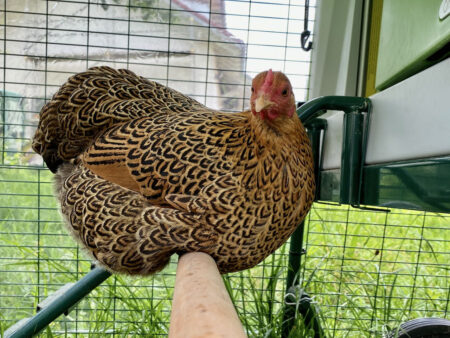 3. Minimize stress
3. Minimize stress
Chickens that experience stress on a daily basis will put all their energy into being constantly on their toes, and will produce no or very few eggs.
Make sure your birds feel safe in their chicken coop and where they are free ranging. A predator resistant coop and run, like the Eglus, will allow your chickens to roost away from any danger. Try to keep cats and dogs away from the area where your chickens are roaming, and let the hens come to you rather than chasing them around the backyard.
Generally, hens will also feel most comfortable when you have a clear routine. Let them out of the coop around the same time every day (made super easy with an automatic chicken coop door), feed them the same feed at the same place, and put them to bed when they’ve all returned to the coop.
Sometimes it’s impossible to avoid a certain amount of stress, for example if you’re moving the hens to a new place or are introducing new chickens to your flock. The chickens should return to their normal laying pattern once things have calmed down, but you could experience a few weeks of disturbed laying.
4. Give them plenty of calcium
Chickens need calcium to create strong egg shells. A good feed will contain a fair amount, but you should also provide your laying hens with an additional source, most commonly oyster shell or crushed, baked egg shells.
5. Provide fresh water
A chicken can drink up to a pint of water a day (!), so it’s important to give your flock plenty of fresh, clean water. Chickens will happily drink from muddy puddles and other water sources, but as standing water can contain bacteria and parasites it’s always best to make sure they have plenty of clean water to drink from their drinker.
This is especially important in the warmer months, as a dehydrated chicken will not lay, but also make sure the water doesn’t freeze in winter.
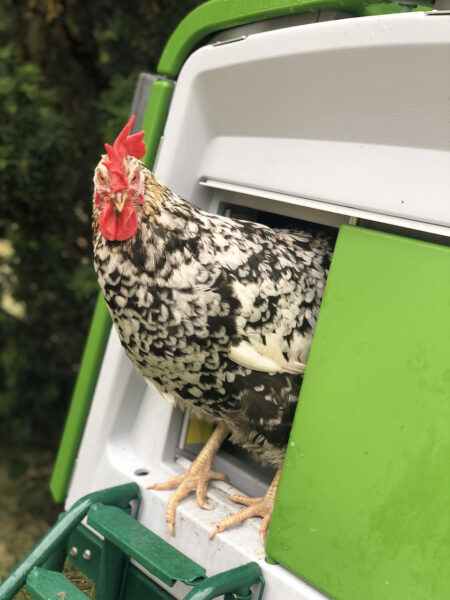
6. Keep parasites at bay
Mites are the number one culprit when it comes to a decreased egg production. They suck blood from the chickens’ legs at night, resulting in the hens being anemic and too tired to lay. Fleas and lice can really annoy chickens and make them stressed, and internal parasites like worms will lower your hens’ immune system and possibly make them very ill.
Get into the habit of checking your chickens over every, or every other, week by picking them up and going through their face, feet and feathers. That way you will be able to spot a potential problem early, and hopefully treat it before it affects your pets and their egg production. You can read more about giving your chickens a health check here.
7. Keep the chicken coop clean
Just like you and I, chickens don’t like sleeping, eating and socializing in mess and dirt. Their idea of cleanliness might look slightly different from ours, but if you want your chickens to be happy and healthy and lay plenty of eggs, you must make sure the coop and the run are tidy and free from droppings and dirt.
With a chicken coop like the Eglu Cube, making sure the hens’ home is clean is super easy. Thanks to the wipe down surfaces and the handy pull out dropping tray, it will only take minutes to clean the coop.
Fill the nest boxes with plenty of soft bedding so your hens have somewhere comfortable to lay.
8. Provide more space
Lack of space can lead to a lot of stress for chickens. While roosting they prefer sitting close together in the coop, but during the day it’s important that they have a good amount of space to move around on.
If you chickens aren’t laying, maybe consider giving them a slightly larger run or area to free range on. Or if you have introduced new hens to your flock, it might be time to buy a second coop to house one half of the group.
Chickens, like most animals, have a defined number of eggs in their bodies, and once they have used up their reserves, nothing you do will make them produce more delicious eggs. If you have rescued ex battery hens for example, the rate of egg laying might slow down quite quickly, despite the hens still being young, as they have lived in an environment where they were manipulated to lay as much as possible, as quickly as possible.
It’s also good to remember that chickens are not machines, and their bodies will sometimes just need a rest. This doesn’t mean they will never lay again, so don’t give up on them! After all, as well as eggs, our chickens provide us with plenty of entertainment and companionship, and they deserve to be properly cared for however many eggs they produce.
This entry was posted in Chickens
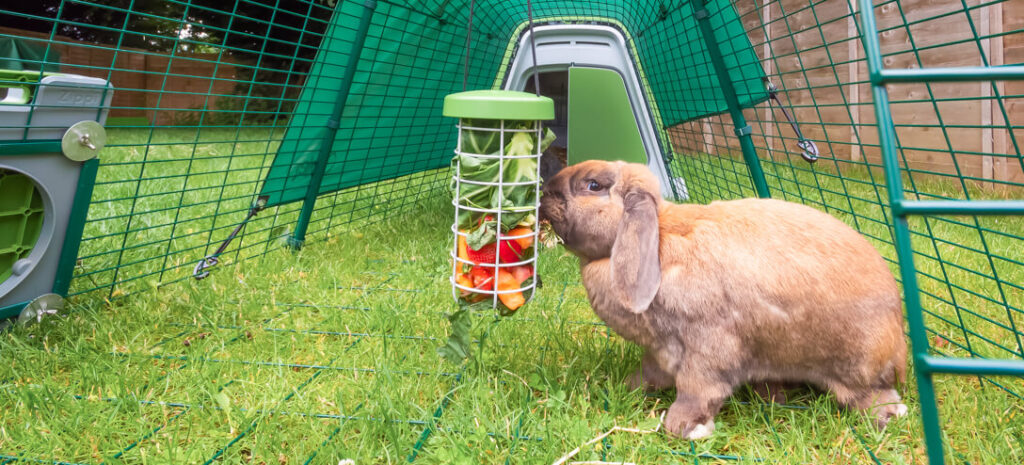
Estimates of the world’s domestic rabbit population vary wildly between 15 million and over 700 million. People have kept rabbits for hundreds of years, and traditionally they were farmed as a plentiful resource – after all, they do breed like rabbits! The larger population estimate includes all the rabbits that are still kept for meat and fur.
With this many rabbit owners around the world, and with the bunny’s rather inscrutable facial expression, it comes as no surprise that the question “is my rabbit happy?” has been asked more than a few times by anxious rabbit keepers.
There are several ways of telling whether your furry friend is content and happy, most of them centering on body language.
Happy bunny body language
Body language is the key way of telling how your rabbit is feeling. Simply by spending time with your bunny, you will learn some of the basic messages that tell you if they are happy and relaxed, or stressed.
These are some of the signs of a rabbit’s mood.
- Twitching nose. Rabbits are constantly twitching their noses. Not only does this help them sniff the air around them, it also eases their breathing, regulates their body temperature and helps them relax. A contented rabbit will do a lot more nose-twitching than a stressed rabbit, so if you notice that your rabbit hasn’t twitched its nose in a while, there may be something distressing it.
- Chilling out. Another easy-to-spot sign of a happy rabbit is an overall relaxed body. Chilled bunnies will lie quietly, ears erect (unless their flop-eared bunnies), sometimes with their legs stretched out, noses twitching contentedly.
- Crouching. Like us, when a rabbit is stressed, its muscles become tense as its fight-or-flight instincts activate and its body floods with adrenaline. If the bunny is in a crouching position, ears flat, pupils dilated, it is anxious, stressed or afraid. The cause could be another pet, a scary noise, or even a whiff of something unfamiliar in the air. This behavior is common in rabbits who have not been hand-tamed from a young age. Alternatively, if your rabbit is chilled out, lounging in the hay and not tensed up in any way, you can be sure that they are content.
- Hopping. When most people picture a rabbit, they imagine a cute creature hopping around. Rabbits have evolved to be great jumpers, with very strong back legs to help propel them at high speeds. Hopping not only acts as a great escape mechanism, it also assists rabbits in their play. Bunnies like to hop around when they are feeling happy and mischievous. Your rabbits may perform the occasional playful leap in their enclosures, jumping in the air, twisting their bodies a little and then landing again, alert and playful. A rabbit showing this type of behavior is very happy with life. A bunny who is gently hopping around and exploring the world around them is also feeling playful and happy.
- Running. A rabbit who darts for cover, usually stamping its back legs on the ground first, is not a happy bunny. Something has startled your poor pet, and the best thing to do is let it recover its composure and confidence in a safe area – usually a quiet corner of the hutch. A quick run to another spot, with ears flat, can also be a sign of anger.
- Curiosity. Rabbits are naturally nervous and will only let their curiosity take the lead when they feel safe. In the wild, rabbits are at the bottom of the food chain, a source of food for many predators. Because of this, rabbits are naturally jumpy (pun intended) and on edge. Domestic rabbits are calmer than their wild relatives but still retain their natural wariness.
Angry bunny body language
These physical clues tell you that your bunny isn’t chilled or afraid – it’s hopping mad!
- Sitting, front legs raised. If your rabbit sits up, front paws raised and flicking in and out as if trying to punch something, it means the bunny is angry – no matter how cute the behavior might look! The ears will be erect (although not in flop-eared bunnies) and facing outwards like radars. The posture may be accompanied by a growling sound.
- Crouching and thumping. If your rabbit is tensed up and thumps its back legs on the ground but doesn’t bolt for cover, it’s angry. The tail will be raised and, in stiff-eared breeds, the ears will be erect. Everything about the bunny will look tensed up, and the pupils will be dilated.
- Crouching with bared teeth. If your bunny is crouched with its front legs stretched in front of it and its head up, teeth bared, it’s angry and ready for a fight. The body will be tense, even quivering, and the mouth will be open, the tail raised, pupils dilated and ears folded back.
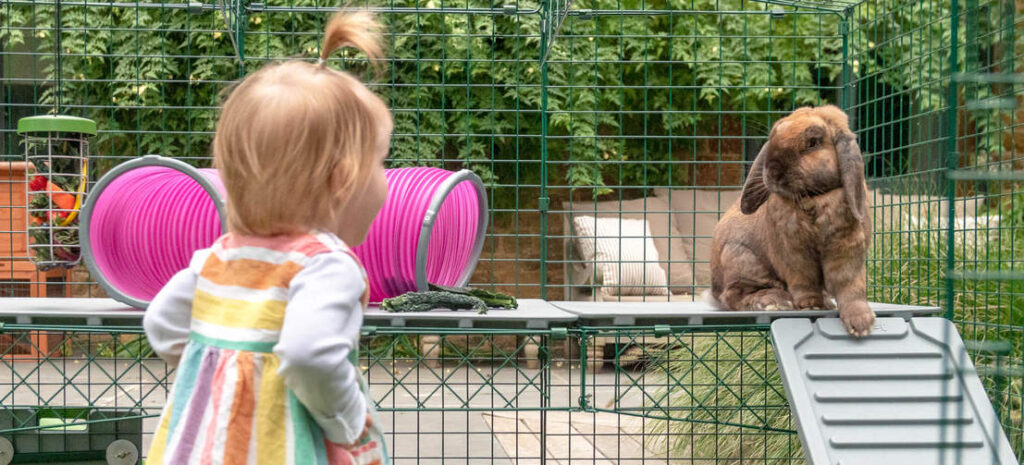
How to make rabbits happy
There are various reasons why a pet bunny might be unhappy or stressed. The commonest cause is poor environment. They need sufficient space in their hutch and run, and they don’t want to be harassed by nosy dogs, cats or loud parties. The rabbits will also need the company and stimulation that enables them to fulfill their natural instincts. Remember – rabbits are social animals and love having other bunnies to play with.
Giving your rabbits regular health check-ups and ensuring they are up to date with their vaccinations is also essential. A healthy diet will go a long way towards ensuring a happy bunny. A high-quality pellet mix and a lot of hay form the basis of healthy diets, with fresh veg as treats.
To summarize, if your rabbit is relaxed around you or shows signs of curiosity rather than fear when introduced to something or someone new, they are almost certainly happy and relaxed.
A chilled-out rabbit is a mixture of nature and nurture. They are naturally skittish animals, but if handled by their owners at an early age, they will come to treat you as part of their safe environment, and their happiness will be obvious in the fact that they love spending time with you.
This entry was posted in Pets
Could your pet be a “Pride of Omlet”?
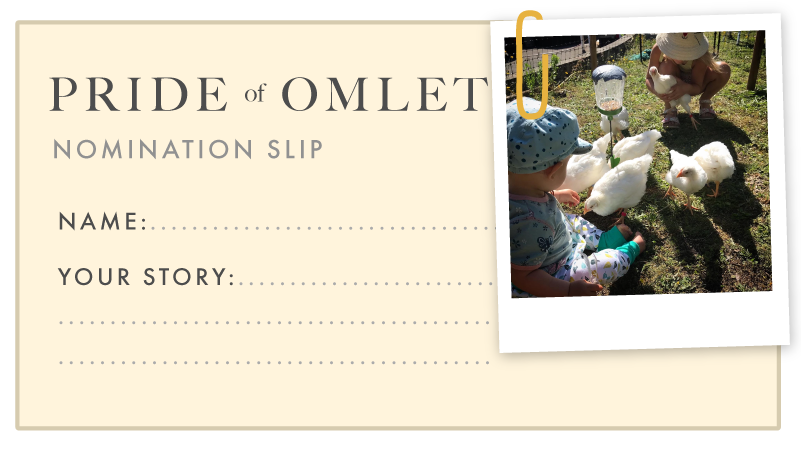
After the amazing stories we received for our first series, we are taking Pride of Omlet to the States!
We’re looking for interesting, relatable, selfless, and exciting pet characters to become the Pride of Omlet, and be highlighted in an exciting blog series showcasing all these brilliant pets!
All you have to do to nominate your pet is email blog@omlet.com with 100 words on an amazing story about your pet, plus a good quality photograph or video of him or her.
The Pride of Omlet pets will be carefully selected and interviewed for an article on their amazing story which will be featured on the Omlet blog and social media channels worldwide!
Has your dog saved someone’s life? Did your chicken learn their times tables? Did your hamster run a marathon?
We want to hear from you!

Top tips for a great nomination!
1) Think of a time when your pet truly amazed you
2) Make sure you have high quality photos or videos of your pet that you are happy to feature on the blog
3) Inject your pet’s personality into your nomination
4) Make sure you’re available for a telephone interview next month!
Entries close 19th September 2021, so nominate your pet now by emailing blog@omlet.com.
The selected Pride of Omlet Pets will win a $100 Omlet voucher, so make your entry count!
Terms and conditions
Please submit your nomination by the 19th September 2021. Up to 10 winners will be carefully selected from all US nominations and contacted by the 22nd September. You must be available for a phone interview during working hours sometime in the last week of September or first week of October. You must provide a high quality photo or video of your pet with your nomination. The winning nominations will receive a $100 Omlet voucher within 30 days following their interview.
This entry was posted in Pets
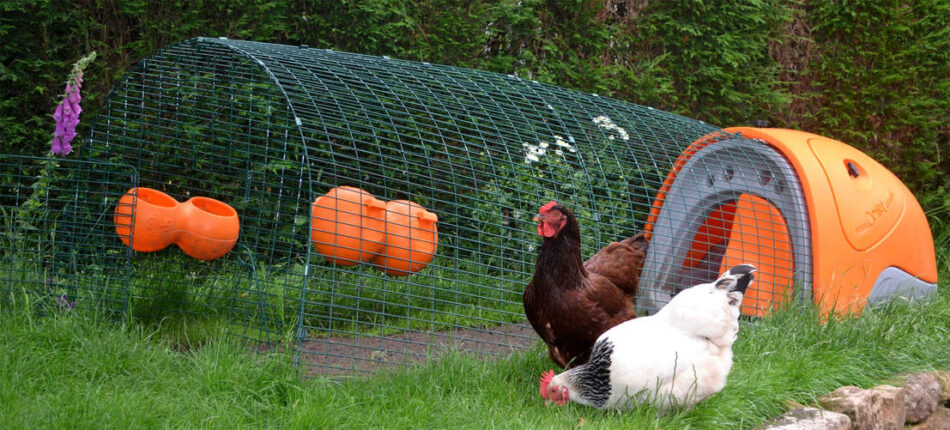
The Eglu Classic Chicken Coop is an easy to move starter chicken house suitable for 2-4 birds.
Unless you know exactly when your hens were born, it is difficult to determine their exact age. We can’t simply ask them how old they are, so we have to make educated guesses based on their looks and behavior.
Like most animals, a chicken’s looks and behavior gradually change as they age. It is the visible evidence of these life stages that helps us determine a hen’s age. Young birds are the easiest ones to identify, as chicks do not have a complete set of adult feathers, beginning life with the short-lived fluffy yellow coating called down. They wear this attractive yellow coat for the first week or so of their lives.
After the first couple of weeks, chicks gradually molt their down and small feathers begin to grow to replace it. A baby chicken can be considered a chick until it sheds all its down, which usually takes around 12 weeks.
So, if a chicken still has some down, chances are it is 12 weeks old or less, although some breeds may take a while longer to shed all their baby fluff. But, generally, the more down, the younger the bird.
From chick to pullet
Once a chick has molted and lost its down, it enters the transitional period between chick-hood and adulthood, the chicken equivalent of teenage years. Hens over the age of 12 weeks are in this phase, and are known as pullets. This period of their lives usually lasts until 20 weeks old, though it can be longer. The name ‘pullet’, though, is generally used for any hen under one year.
Pullets are considered adults when they lay their first eggs, which occurs somewhere between 18 and 25 weeks. Male chickens – cockerels, or roosters – reach adulthood when they start to crow and show an interest in the hens, usually by chasing them. This occurs at around five months old, although some breeds are later developers.
At this point in a chicken’s life, when it has finally become an adult bird, it is hard to pinpoint exactly how old they are. If your hens are not laying eggs yet but have all their adult plumage, they are most likely somewhere between 12 and 20 weeks old. Young hens of this age will tend to have smaller combs than fully adult birds.
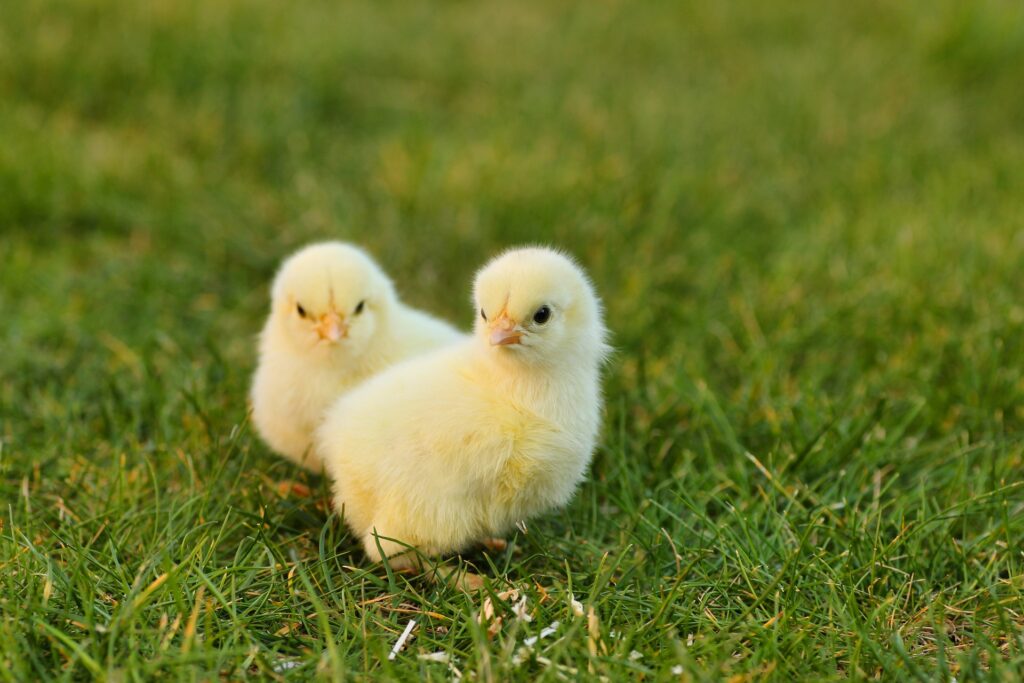
From pullet to adult hen
If you are keeping multiple hens, it can be hard to tell if an individual bird has started laying or not. Pullets will have small, dry and pale vents in comparison to hens, and this can be used as a way of telling whether or not they are laying.
During this post-20-week period, both the pullets’ and cockerels’ combs and wattles will gradually become brighter and more pronounced. Birds with less vibrant combs and wattles are most likely to be aged around 12-15 weeks. It is during this prime egg-laying stage of a chicken’s life that their combs and wattles will be at their most vibrant – as a hen ages, it slowly loses the red color.
Hens increase their body mass as they mature, and most have reached maximum plumes at nine months old.
Signs of an adult chicken
Once your pullet has laid its first egg, and your cockerel has started crowing and harassing the hens, they have reached adulthood. Despite the fact that they are considered adults at this point in their lives, they are still growing (albeit slower) and will reach their final size and weight at around one year.
At this age, hens will usually be laying one egg per day, and the cocks will spend a lot of time chasing the hens. At the age of 18 to 20 weeks, the chickens will have their first feather molt.
Guessing the age of a fully grown chicken that has had its first molt is more challenging. However, there are some features that help us determine their age with reasonable accuracy.
- A young cock will have short spurs, a little under 1cm in length. By the time your rooster is two years old, their spurs will have grown and may reach lengths of 2.5cm-3cm.
- Hens that lay an average of five to six eggs per week are probably in the first two years of their life
- For the first two years of their adult life, both hens and cocks will be in their prime. This manifests in vibrant feather colors, smoother legs than older birds and colorful combs and wattles.
Older hens and roosters
At around the second year of their lives, chickens will enter the second half of their adult lives. It is usual at this time for hens to stop laying daily, and cockerels will start showing less interest in the hens.
During this time, a chicken’s legs will start to get rougher and scalier, and their combs, wattles and feathers will become less vibrant.
However, although past their prime, at this point in their lives, a chicken will still have around between two and five years left in them, depending on the breed. As they get older, hens will only lay occasionally, and the eggs may be larger than the ones they laid as young birds. However, some breeds continue laying into their fourth year, and some can live up to 10 years or more.
This entry was posted in Chickens

Photo by Joe Caione on Unsplash
Getting a new puppy is such an exciting time for everyone involved (even if it means a manic few months ahead of you!). A cross between a poodle and cocker spaniel, cockapoos have soared in popularity over the past few years, with their hypoallergenic coat and undeniably cute looks both playing a huge part in this! With such a loving and fun temperament, it’s hardly surprising that they have become a new firm family favorite. So, now you’ve decided that a cockapoo is the right puppy for you, where exactly do you start? Writing a puppy checklist is a good idea to get prepared before you bring your pet pooch into their new home.
Essentials for Before They’re Home
The first few days with your new puppy might be tough, as they adapt to your life and you become familiar with your four legged friend. Every dog is different but there are some essentials that we recommend for your cockapoo before even bringing them home that will make for a much easier start.
Food and Water (Including Bowls)
Puppies, of course, need a fresh supply of food and water (along with appropriate sized bowls for each). A reliable cockapoo breeder will tell you know what food your cockapoo puppy has been on before they come home, to make for a less stressful transition. Be sure to also purchase treats for your new furry friend. They’re a fantastic way to start the training process and will keep your puppy motivated.
Collar and Leash
When you pick your puppy up, they’ll probably have had a collar on to differentiate them from their litter-mates. However, you’ll want to purchase your own, even before they are able to go for their first walk. This will help to train them to get used to the feeling of a leash and collar. For size reference, cockapoos are generally medium sized dogs but this can range depending on what type of poodle they are mixed with. The general rule of thumb is that you should be able to fit two fingers under your cockapoo’s collar. Alternatively, you may wish to opt for a harness. Whichever you decide for your new cockapoo pup, make sure they are fitted with an ID tag, which states your name, first line of your address, postal code, contact number, and a message that indicates that your dog has been microchipped i.e. “I’m microchipped”.
A Crate and Bedding
When you bring your puppy home you should introduce them to a crate. A crate should never be used as a cage or to punish your dog, but should work as a den for your new cockapoo. The Omlet Fido Studio Dog Crate allows your dog to have their own private and safe place in the house, while the modern design will complement your home. Happy owner and happy pup!
Puppies need sleep, and a lot of it! So comfortable bedding for your cockapoo puppy is essential. Your Fido Studio Crate can also be very easily fitted with a wide range of dog beds. The easy clean Bolster dog bed is perfect for puppies and it’s quick and easy to zip off the cover to throw in the washing machine when it’s time for a freshen up!
A Few Extras For Your Cockapoo
Puppy pads
Cockapoos are remarkably intelligent and many puppies take to toilet training within the first few weeks. For when your pup arrives home it really is a personal preference as to whether you’d like to use puppy pads for toilet training or not. Puppy pads are massively convenient, especially to those with limited outdoor space. However, if getting up in the middle of the night to take your puppy to the bathroom isn’t a problem for you then you may wish to avoid this product as your pup may find it difficult or confusing to transition between the pads and outdoor peeing.
Toys
Pups love to play and cockapoos are no different here. Known for their outgoing, playful personalities, you’ll need to be stocked up with plenty of puppy toys to keep their minds occupied. Toys are also great for when you have to start leaving your puppy alone. Do make sure however, that any toys you leave with them are safe, age appropriate, and cannot be consumed! Puppies also love to chew, especially as they get into the teething stage. Be sure to explore different styles of dog toys to see how you can keep your cockapoo entertained and help with their chewing.
Grooming Kit
Although it’s wise to take your cockapoo to a professional groomer now and again, it’s also important to upkeep their grooming at home too. Purchasing a brush, comb, dog shampoo, and nail clippers is a great place to start. However, as cockapoos are of course a mixed breed, their coat type may vary. When your puppy reaches around seven to nine months old, they’ll develop their ‘adult coat’ and you will have a better indication of the best way to groom your dog.
Hopefully all the time spent preparing to bring your new puppy to their new home will help your family to transition better to life with your new furry friend!
This entry was posted in Dogs
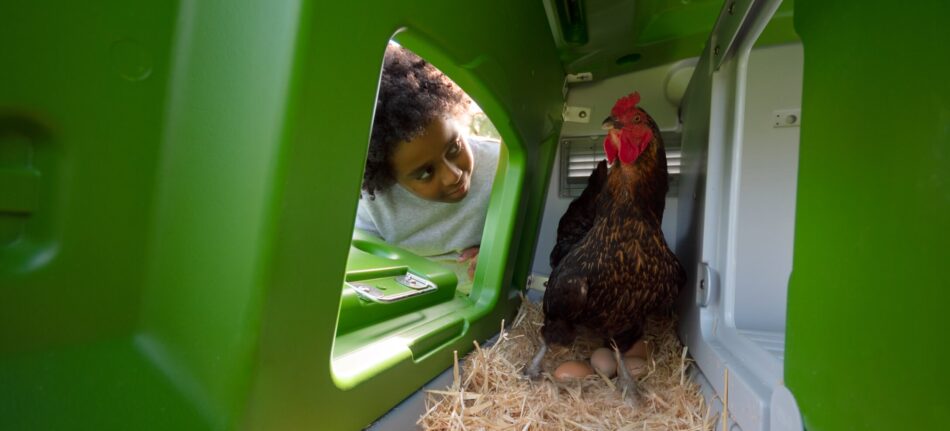
Why won’t hens lay in their nesting box? Chicken keepers sometimes find themselves picking eggs up off of the ground or in other inappropriate places. It’s frustrating when hens decide to ignore the carefully placed and meticulously kept nesting boxes you have provided them with, and instead choose to lay their eggs wherever they see fit. Hens thrive on routine, so once they create a habit of laying eggs wherever they’d like, it can be hard to convince them otherwise. See how you can retrain your hens to lay where they should, or to prevent them from deviating from the nesting box in the first place.
Understanding egg-laying behavior
To begin unraveling the mystery of why hens lay their eggs outside of their nesting box, it helps to understand what might be causing them to veer away from their normal routine. Healthy hens that feel their best will naturally seek out comfortable, secluded spaces to lay their eggs. And, as flock animals, they will gravitate toward a location where other hens have chosen to lay – happily contributing to the previously laid eggs.
Hens that suddenly start routinely laying their eggs outside of their nesting boxes are likely:
- Not feeling well
- Reacting to a perceived threat
- Don’t feel comfortable in their provided nesting area
- Feeling crowded in their space
Broody hens also run off other hens that may be trying to lay in the nesting box. A hen that has decided to sit in order to hatch eggs will stay in the nesting box for the required 21 days if they aren’t made to move. As most broody hens are aggressive and territorial, they will protect their nest and not allow other hens to lay their eggs in the box.
Why is it a problem for hens to lay eggs outside of the nesting box?
Hens that aren’t laying their eggs in the nesting box are communicating to you and the rest of the flock that they either aren’t feeling well, or that something is amiss in the coop. And, eggs that are laid outside of nesting boxes are easily crushed or cracked, which will cause hens to eat them. Chickens can and will eat eggs left in the coop or run.
Most hens don’t eat eggs from nesting boxes, but once an egg is cracked, it becomes a protein-packed treat for chickens. And, once hens develop a taste for eggs, they will likely begin pecking at the eggs inside of the nesting boxes in order to crack into them.
Remember, hens will follow the lead of their flockmates, so once one hen begins laying eggs in the coop or run, others will soon follow suit. One stray egg isn’t usually a cause for concern, but multiple days of one or more eggs on the ground requires prompt attention to correct what can lead to a less-than-desirable habit.
10 steps to keep hens laying in the nesting box
Young hens naturally take time to get used to laying eggs and in the same place each time. But, if your adult hens aren’t getting the hang of laying in the box, or suddenly stop laying where they should, try some of these steps to get them back on track.
1. Make sure you have enough nest boxes
Hens need to have adequate space to lay their eggs. But, if too many nesting areas are offered, hens may begin sleeping in the extra spaces, which will create an undesirable habit. Nest boxes don’t necessarily have to be separated, just spread out enough so that hens don’t feel that their eggs are being crowded. The laying area of the Eglu Cube chicken coop is long enough for up to 10 hens to comfortably find a place to lay their eggs.
2. Make the nest boxes clean and comfy
The nest box should have lots of soft bedding, changed regularly to make sure it remains unsoiled and free of red mites. You also need to collect the eggs regularly, as a hen faced with a pile of eggs might not want to sit there and lay one of her own. A nesting box with just one egg or none is more appealing to a hen.
Make sure your hens’ nesting box is clean and the bedding is deep enough for them to nestle down in order to lay their egg. If a hen feels there isn’t enough bedding in a nesting box, they’ll hop up and search out a place with more padding. Keep your chickens’ coop clean so that red mites don’t take up residence in the nesting area – causing your hens to vacate the box altogether.
3. Provide enough roosting bar space
Roosting space is important to hens not only for bedtime, but for creating and maintaining healthy egg-laying patterns as well. Hens that don’t feel like they have enough room to roost will head to bed in the nesting area instead. As the bedding gets flattened down and the droppings accumulate overnight, the nesting box will not be an appealing place to lay eggs by the following morning.
4. Place a decoy egg
This trick works best with young hens that are beginning to lay, or for those that have just started laying outside of the box. Decoy eggs made of wood or rubber can be purchased or made to place in the nesting box to encourage hens to lay there. You can also place an extra egg from a previous collection from the coop, or put the egg that was laid in the run inside of the nesting box to give your hens the right idea.
5. Keep hens in the coop first thing in the morning
Sometimes hens get so excited to seize the day that they neglect to come back to the coop to lay their eggs. This results in eggs being laid in random places around the run. To combat this issue, you can install an automatic chicken coop door to keep them inside of the coop during the wee hours of the morning. But the benefits of the Autodoor doesn’t stop there – see why everyone loves the Autodoor by Omlet.
6. Make it harder for the hen to lay in the wrong place
As creatures of habit, once an egg-laying spot has been found outside of the coop, your hens will likely return to the same place again and again. To prevent them from returning to this spot, place a Freestanding Chicken Perch or other types of chicken toys over it to let your hens know that this is no place to lay eggs.
7. Move the hen before she lays
If you happen to catch your hens in the act of laying, quickly move them to the nesting box. You’ll notice a hen getting ready to lay an egg when they stop their foraging or dustbathing and hunker down. They’ll fluff up their feathers and sit very still – sometimes making soft clucking noises in the process.
8. Stop hens from sleeping in the nesting boxes
Hens that sleep in the nesting area will flatten the bedding and leave droppings – which will make for a soiled, undesirable nesting spot for the next day. Quickly shoo any hens snoozing in the nesting area before a habit is created. The Eglu Cube has a divider between the roosting and nesting areas that can be closed each night to help break or prevent this habit.
9. Make sure the hens feel safe in the box
Nesting areas that are too close to the ground, are subjected to intense light, or are too noisy, your hens may not feel comfortable laying their eggs in them. Hens will seek out quiet, dark, and secluded areas to lay their eggs. The Eglu Cube has a designated separate area for laying, where hens will feel safe and secure. And, once your hens have paid the nesting area a visit, you can easily check their work through the dedicated egg access door.
10. Make sure your hens can easily access the nesting box
Nesting boxes should be low enough for your smallest hen to comfortably access, but not so low that it makes hens feel unsafe. Your hens will try to find a safe place to lay an egg, and like their roosting habits, they feel safer off of the ground. Make sure roosting bars or other chicken coop components don’t block your hens’ access to the nesting area. Keep the path to the nesting box free of obstacles so that your hens can head in to do their business quickly and discreetly.
Omlet and your hens
The Eglu Cube chicken coop by Omlet has been designed to make your flock feel safe and comfortable for all of their activities. From laying eggs in their secluded nesting area, to playing in their chicken run, your hens are sure to feel confident in every area of their space.
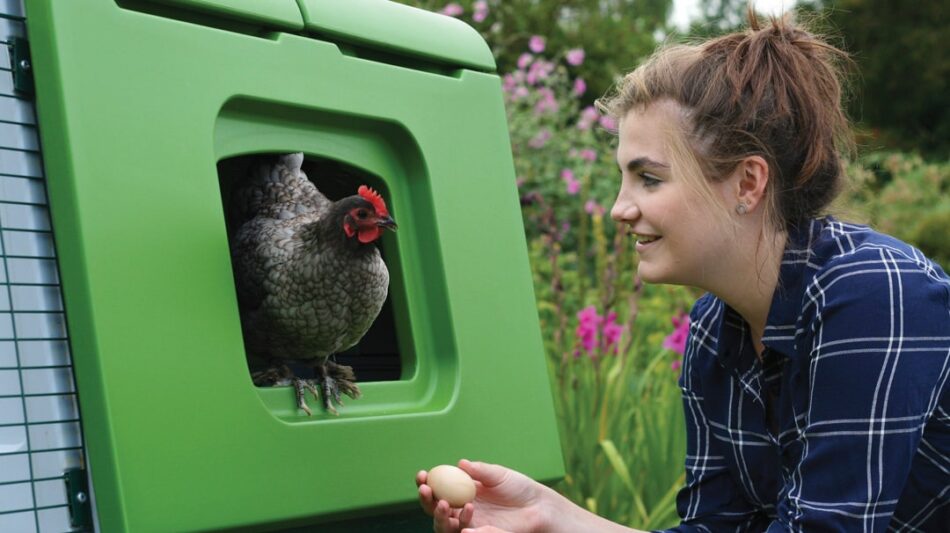

This entry was posted in Chickens

For years dog owners have been limited to beds in dull shades of brown, grey and black, but things are about to change! The Omlet Bolster Beds are now available in 15 amazing colors, ranging from a stylish Meringue White to an eye-catching Cherry Red, so there is sure to be one you will love.
Are you having trouble choosing? Why not try and match the color of the bed to your dog’s personality? We’ve put together a quick quiz that will help you establish which color Bolster Bed will be the perfect style for your pooch. Choose the answers that most resemble your dog, and add together the results at the end to find out which color will suit them best!
What is your dog’s idea of a perfect day?
A. Snoozing on their bed not getting disturbed
B. Playing with the other dogs in the park
C. Going for a walk in the city sniffing outside shops
D. Digging a big hole in the garden
E. Hiking up a mountain
What’s your dog like with strangers coming to your home?
A. Doesn’t pay any attention to them whatsoever
B. Jumps up and down and barks as soon as someone knocks on the door
C. Comes to have a look, but then goes back to whatever they were doing
D. Tries to get a belly scratch from anyone, doesn’t matter if they’ve never met them before
E. They will love to come and say hello, but can tell if the guest doesn’t want to play with them
What is your dog’s coat like?
A. Very, very fluffy
B. Long in some places, short in others – a bit of a mess really
C. Perfectly soft and smooth, we brush it every day
D. Short and easily maintained
E. They’ve got a lot of it, that’s all I’ll say
What is your dog’s favorite treat?
A. Dry duck filets
B. Filet’s from the butcher
C. Ridiculously expensive organic dog treats
D. Probably pizza, or anything else they’re not supposed to eat
E. Just normal dog treats will do
How does your dog feel about bath time?
A. They hate it!
B. Bath time? Are you supposed to wash dogs?
C. Loves it, especially at the groomers
D. They enjoy getting sprayed with the hose outside, but I wouldn’t trust them in my bathroom
E. They accept it, but they’re not a big fan
What is your dog’s favorite time of year?
A. Springtime, it’s warm but not too hot
B. Summer, they love going to the beach
C. They really don’t like snow, but apart from that they don’t really mind
D. Christmas, or any other time when the whole family is together
E. Probably autumn, they love jumping in the leaves
What would be your dog’s reaction to meeting a squirrel on your walk?
A. They would just look at it and keep walking
B. They would chase it up a tree, then try to climb the tree themselves
C. They would bark, but wouldn’t run after it
D. They would run after it hoping to make friends
E. They would look at me, asking for permission to chase the squirrel
If your dog was reading a book this summer, what type of book would it be?
A. A book about World War II
B. Something the other dogs in their doggy book club had chosen
C. A romance novel
D. The latest crime best seller
E. A Russian classic

Mostly As: It is clear that your dog is as relaxed and easy going as dogs come; they are happy to go along with most things as long as they have a comfy bed to come back to for a snooze. A Mellow Yellow bed will be perfect for him or her to rest their head on after walks and play.

Mostly Bs: Your dog is a feisty one, full of energy and play. We think that a Mocha Brown bed will be perfect for him or her. The soft and subtle brown color will look great in any room of your house, and against whatever color your dog’s coat is. As a bonus, the inevitable muddy paw prints front our dog’s adventures will be camouflaged on the bed!

Mostly Cs: Midnight Blue is no doubt the color for your dog. A stylish and sensitive soul, he or she will love relaxing against the calming blue after a busy day out on the town, and you will appreciate the way the dog bed adds a bit of color to your home while still blending in nicely with the rest of your furnishings.

Mostly Ds: It’s clear that your dog will love a Lavender Lilac dog bed. They are a social creature who want nothing more than to spend time with their favorite humans, it doesn’t matter if it’s on a walk or lying in the corner of the kitchen while you’re having dinner. The relaxing dark purple color will be great for when they are tired and need to wind down.

Mostly Es: Your dog is adventurous and has lots of energy, he or she probably never slows down, and is always happy to chase a ball in the backyard or park or go for a run across the fields. You’re probably very similar, so we think a Matcha Green bed will be perfect for those rare times when they actually retreat to their bed to rest those legs.
This entry was posted in Dogs

Many of us have worked from home over the past year with our best furry friends beside us, giving encouragement and comfort on the toughest of days. It’s understandable for those people that going back to the office without their canine companion could be nerve wracking and upsetting. For the dogs who are now used to constant company, new spouts of being home alone could lead to anxiety and stress. But what if there was a better solution? What if your workplace was dog-friendly? Read on as we take a look at the benefits for all parties…
How do dogs improve our mood?
It’s no secret that dogs, and pets in general, are good for our physical and mental well-being, whether that be through easing loneliness, encouraging exercise, or reducing anxiety, stress and depression. You might have felt it yourself when returning home to your dog, or perhaps going to visit a friend’s new puppy. Interacting with dogs increases our levels of the hormones oxytocin and serotonin, which are important for the regulation of stress and anxiety and also improve our mood and happiness.
Having a dog present in an office environment can significantly elevate the mood, while also improving communication, reducing tension and increasing productivity!
Can a dog-friendly workplace benefit employers?
Not only will your boss enjoy the mood-boosting benefits of a new four-legged colleague, they may also begin to notice some practical benefits for their business too.
For some employees, especially those who have been working from home for a long time now, going to the office requires someone to look after their dog, perhaps hiring a dog walker to take them out or even a hurried trip home in their lunch break to check on their dog. Understandably, this in itself can be a cause of stress for any dog owner, and being able to take their dog to the office with them is a huge job-perk which could be hard to walk away from. Could a dog-friendly office actually improve employee retention? Woof!
Do dogs enjoy going to the office?
Obviously it’s not all about us. If you’re going to be taking your dog to the office you also need to consider whether he/she will be comfortable with the new environment.
If you’re thinking about taking your dog to work for the first time, you may have to accept that the first few trips won’t necessarily be a walk in the park! Start slowly if you can, introducing your dog to colleagues and spaces gradually so as to not overwhelm them. Have a bed next to your desk so your dog can see you at all times and reward them with treats and pets regularly.
Maybe not after the first visit, but hopefully soon your dog will relax into the new environment just as if they’re at home, and new faces, sounds and smells will no longer be a cause of excitement or stress. Instead, they will feel the benefits of being close to you, just as you do!
What should you consider before taking your dog to the office?
If your boss has given the green light to bring your dog to the office, there might be some things to check before going ahead. Of course, check in with your colleagues that no one has allergies or is afraid of dogs. If other colleagues are also going to be bringing their dog to the office, consider whether your dog will be okay with that, or if it could cause some stress.
Make sure you can schedule breaks in your day to take your dog outside to stretch their legs and go to the bathroom – this fresh air time is also great for your own well-being. Make sure you have everything with you, including treats, poop bags, a water bowl and a comfy bed where your dog can feel comfortable and relaxed. You may wish to keep a set of these items at the office if you’ll be bringing your dog with you regularly.
Whether or not you decide to take your dog to the office, the most important thing is that your dog is happy and comfortable. If you are returning to full time office working, consider your options to decide what’s best for your dog.
This entry was posted in Dogs
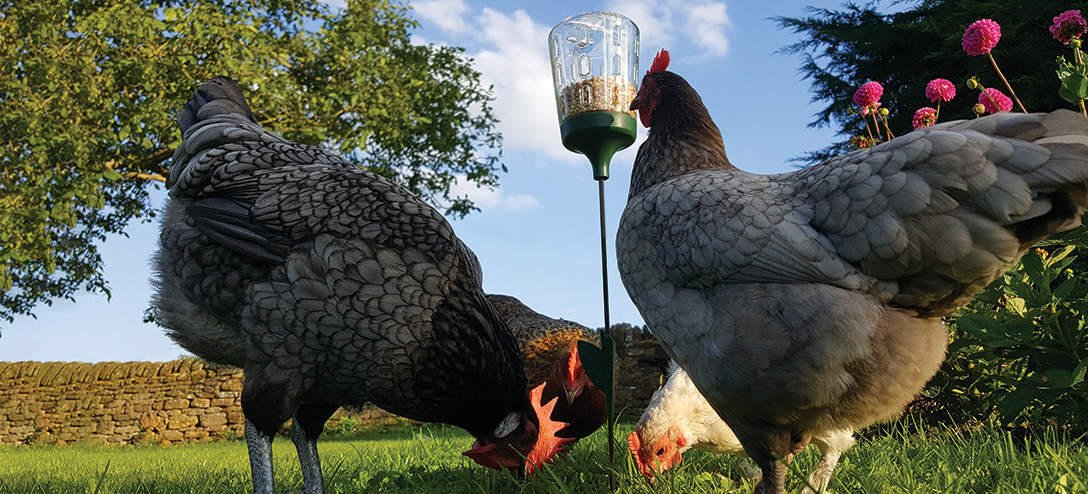
Chickens are not only great companions, but also a great way of being more resourceful, providing you with a frequent supply of fresh eggs. However, you could have a problem on your hands if you begin to notice that a few eggs are going missing. Sometimes chickens develop a bad habit of eating their own eggs, which although is not detrimental to their health, is a sure sign that something is not right.
Your Chickens are Bored
Your poor chickens may simply be suffering from boredom! Boredom in chickens can occur when they either don’t have enough space to roam, or they’re lacking facilities to keep them entertained.
For a happy hen, they need a bare minimum of 1 square meter each in their run, however 2 square meters plus (per hen) is always preferable. Chicken toys are also a fantastic way to keep your chickens entertained. How about trying out the Omlet Pendant Peck Toy, an interactive and engaging feed toy that not only improves flock behavior but will provide your hens with the mental stimulation they desire.
Dehydration
Chickens that eat their eggs may be dehydrated. Since eggs contain a large amount of water, your chickens may be resorting to eating them simply to keep themselves hydrated.
To stop egg eating behavior, make sure that your hens are supplied with a clean water bowl/feeder at all times. During the warmer summer months, chickens need a lot more of it, so add some ice to their bowl or feeder to make sure they stay on top of hydration.
Vitamin Deficiency
A vitamin deficiency can be another reason as to why your hens have turned to egg eating. Your chicken’s diet is fundamental to their wellbeing, and a poor one could be depriving them of their nutritional requirements. Along with eating eggs, broken eggs can be another indication that your chicken is vitamin deficient, more specifically suffering with a calcium deficiency.
It’s important to provide your chickens with a balanced diet of enough protein, carbohydrates, vitamins, and minerals, so although they naturally forage, you should supply your chickens with a good quality feed. For added calcium, it’s recommended to add grit, a ground hard substance, to your chicken’s diet, which aids with digestion. Surprisingly, you can feed your hens crushed eggshells, or alternatively, you can use crushed oyster shells – a high calcium, soluble grit.
Inadequate Nesting Facilities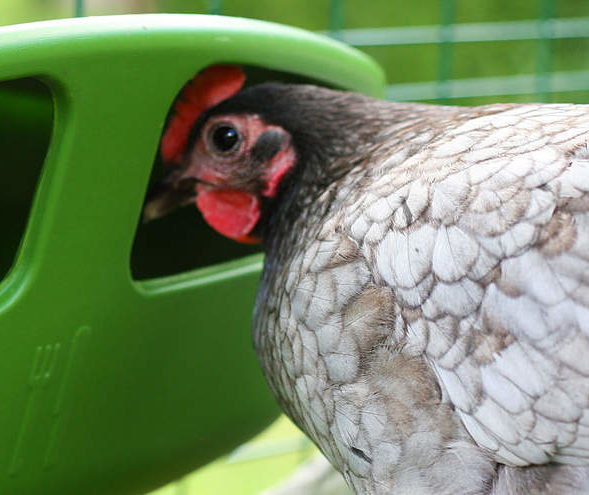
Your nesting box needs to be a secure and safe space for your hens. Egg eating can occur when your hens are uncomfortable with the nesting box, most commonly due to the bedding itself or exposing your chickens to too much light.
First of all, make sure that their nesting area has adequate bedding and is made of a comfortable nesting material. There are a number of choices of bedding to choose for your hens so if you notice that they are not getting on with what you’re currently using, try changing their bedding to see what works best for them. You’ll also want to keep on top of cleaning their bedding by replacing it weekly, also removing any droppings. The Eglu chicken coops make for easy cleaning, with integrated and private nesting boxes, whilst offering plenty of space that your hens will love.
An Anxious or Stressed Chicken
Chickens found to be eating eggs can also be suffering from stress or anxiety, which your hens can be experiencing for a number of reasons. Stress-inducing scenarios can be related to either handling, a new environment, the introduction of new chickens, extreme heat, or regular visits from predators.
Having an anxious hen isn’t pleasant for either you or them but fear not, as there are steps you can take to help minimize stress to help your egg eaters. Some stressful situations are easier to tackle than others, such as introducing new chickens or handling if these are two stressors. Take a look at Omlet’s guide on introducing new chickens for some more help.
Still Struggling?
If you’ve tried all of the above, ruled out anything medical, and yet your flock remain stubborn with their egg eating habit, here’s what else you can do to try and tackle the problem:
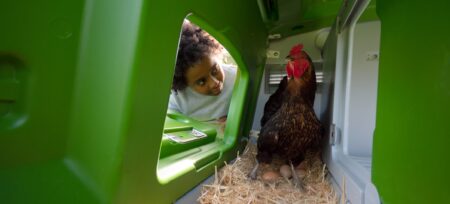
Quickly Collecting Eggs
Quickly collecting eggs once they have been laid will give your chickens, or particular offender if it is just the one hen, less opportunity to eat the eggs. If possible, check the next box four times a day to start with. Hopefully after a few days, this will break the habit, and you can go back to collecting the eggs once a day.
Fake Eggs
Fake eggs can be made of wood, rubber, or ceramics and will leave your chicken pecking but will eventually become frustrated so that they’ll stop attempting to peck at real eggs.
Using Mustard
Create a small hole in your egg, empty the contents and fill with mustard. Mustard is a flavor that (most!) hens can’t stand so after a few attempts, they’ll likely stop attempting to eat eggs.
If you do have an egg eater on your hands, don’t panic! It may seem a bit odd, or the behavior might confuse you but with a few tips you can get the habit well under control. Hopefully next time you go to collect eggs, you’ll have happy laying hens, with your eggs still intact!
This entry was posted in Chickens
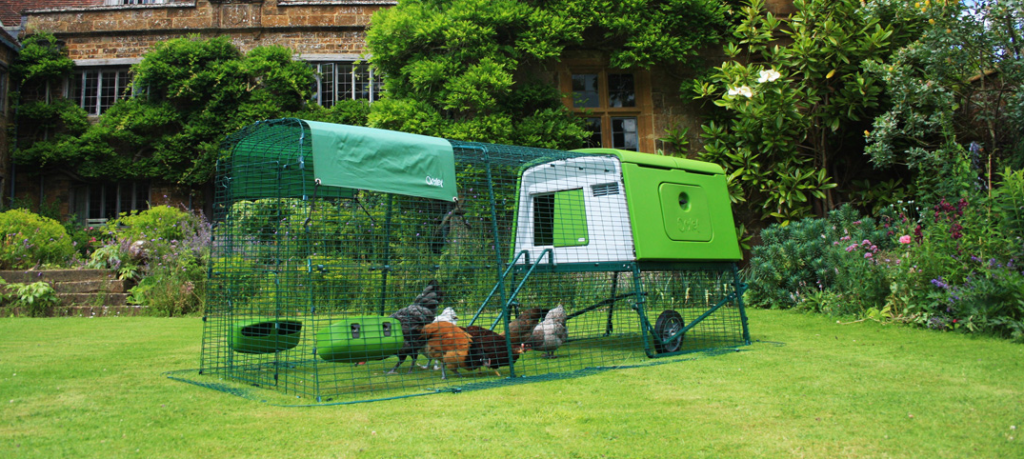
The metal chicken runs are designed to be used outdoors for years to come. However, we recommend that you check the run regularly for signs of corrosion, especially if you live somewhere with extreme weather conditions or close to the sea. Corrosion will occur if the coating has been scratched or scraped for example. If you do see some, remove any loose rust and touch up with a weather resistant paint.
Are you a long term Eglu or Walk in Run owner? Omlet products are known to be extremely long lasting, but we do recommend checking over your coop and run every year for signs of wear and tear, and to remember the little maintenance needed to keep your coop in tip top condition and your pet happy and healthy. You may have also missed some of the new products we have developed over the years to make the coop and runs even better. Take a look at ways you can upgrade and improve your Eglu below!
Run Clips
When you carry out your regular deep clean, make sure you have a quick walk around the run and check the security and stability of the run panels. In time, the run clips can age and become weaker. If you notice that run clips are cracking when you open them or move the coop and run, or that there are some clips falling to the ground, you should consider refreshing all the run clips on your coop.
We have now made it super quick and easy for you to find the right pack of run clips for your Eglu or Walk in Run.
New Ladder
If you purchased your Eglu before summer 2019, you may not have benefited from the new Ladder Grips we have designed to resolve the problem of some chickens disliking the metal coop ladder, or being too small for the steps. The ladder grips replace the black friction strips, clipping on securely and easily to provide a wider platform for chicks to climb up on.
You can buy ladder grips for your Eglu Cube here or for your Eglu Go UP here.
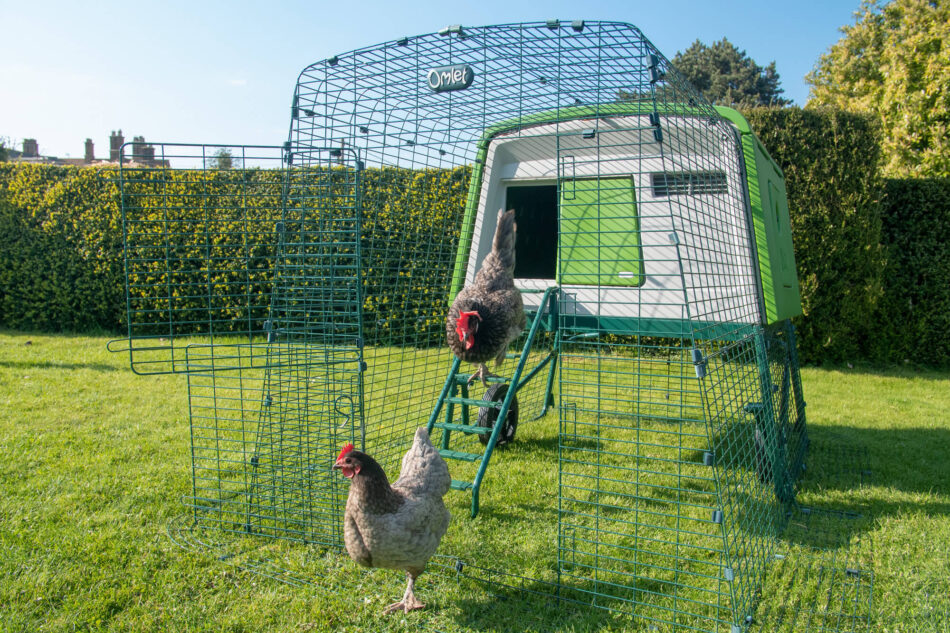
Autodoor and Coop Light
We’re sure you haven’t missed the Automatic Chicken Coop door that can be attached straight onto your Eglu Cube or Walk In Run, but have you seen that you can also attach a coop light to guide your chickens in at night? The light is powered by the control panel of the Autodoor, and will automatically come on 5 minutes before the door closes. As soon as the door has closed for the night, the light turns off.
Run Covers
In high winds and torrential rain, old run covers can take a beating. If you have had your run covers for some time and they are looking a bit worse for wear, it might be a good idea to invest in a new set of covers to ensure your chickens continue to be fully protected from the elements.
Discover our wide range of run covers for all Eglus here.
New hentertainment
We have also introduced new feeders and treat dispensing toys in the last few years, which your chickens are sure to love.
The Caddi Treat Holder is ideal for larger treats, such as fat balls or vegetables from your garden, and hangs in your run to keep food off the ground and prevent mess on the run floor. The Peck Toys are a rewarding, slow release solution for treat-dispensing which your chickens will be entertained by all day. The Pendant hangs from the run, while the Poppy is put into the ground – perfect if your chickens are fully free ranging.
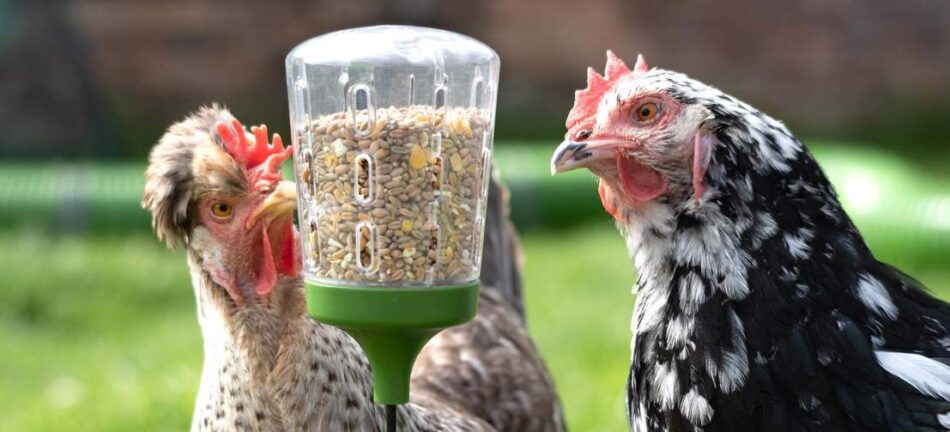
We’re here to help
If you are unsure about the condition of your Eglu or your run, please contact our friendly and knowledgeable Customer Service team. They can give you advice on how to maintain your product, making sure it’s in top condition for many years to come!
This entry was posted in Chickens
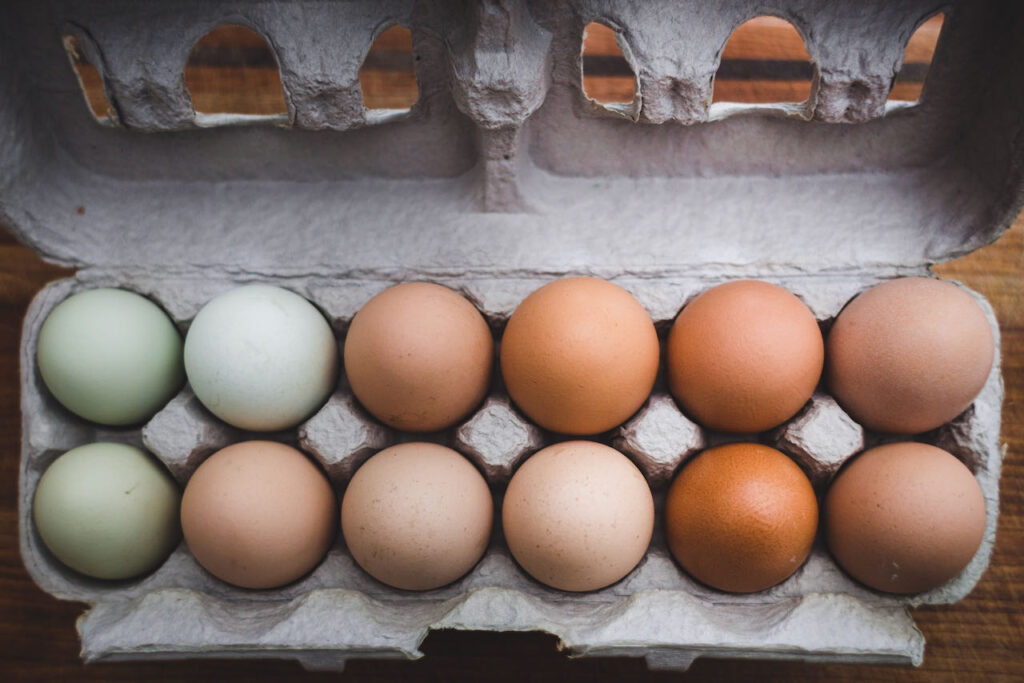 Chickens sometimes lay eggs that look nothing like a standard supermarket egg. Some are huge, some are tiny, some are ball-shaped, some are pointy, and some are soft-shelled. There are various reasons for these oddities.
Chickens sometimes lay eggs that look nothing like a standard supermarket egg. Some are huge, some are tiny, some are ball-shaped, some are pointy, and some are soft-shelled. There are various reasons for these oddities.
Each hen will have her own ‘quirks’ in terms of egg size and color. Although most chicken breeds lay light brown eggs, some have eggs with pigmented shells. A hen will produce eggs of the same color throughout her laying years. The palette ranges from deep browns to light blues and pastel greens, with speckling adding another dimension of prettiness.
Odd shapes and sizes are something quite different, though. They are quirks rather than breed-specific traits.
Why are chicken eggs sometimes bigger or smaller than usual?
A huge egg contains two yolks. In these cases, the hen has doubled up on her usual daily production and has had to produce a giant egg to accommodate the extra mass. These eggs usually have smaller-than-usual yolks, but they look very eye-catching in the poaching or frying pan!
Young birds often produce small eggs, and they will begin laying regular eggs very quickly. Some smaller bantam breeds produce small eggs all the time, of course.
Why are chicken eggs sometimes misshapen?
An oddly shaped egg can be produced for various reasons. It often takes young hens an egg or two before they settle into their regular pattern. Stress in the chicken coop can lead to misshapen eggs too. This is usually due to a hen having the urge to lay but finding her space in the laying box occupied by another bird.
Misshapen eggs can be elongated, or they may have a thin, pointy end. Sometimes they are rough-looking, with craggy rather than smooth surfaces, or with thicker bands of shell running across their middles. In all these cases, the egg inside is unaffected and is perfectly safe to eat.
A ball-shaped egg is usually a sign of slight calcium deficiency. The round shape requires less calcium than a normal oval egg.
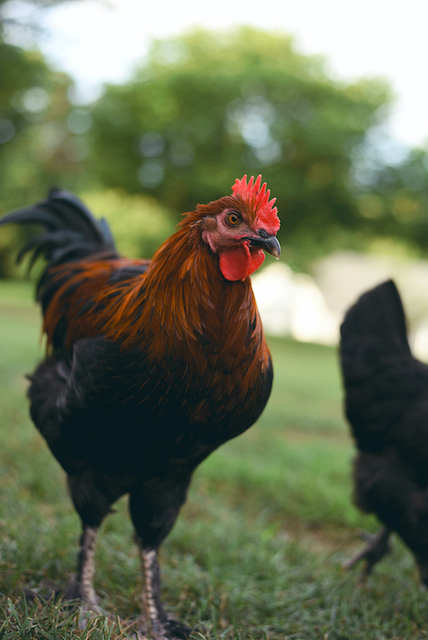
Are oddly shaped chicken eggs a sign of illness?
Infectious bronchitis can lead to misshapen eggs. An infected hen will stop producing eggs for a few days or will only lay intermittently. The eggs she lays will have thin, wrinkled or rough-shelled eggs, and the white of the egg will be watery. It is also common for the affected eggs to have lighter-colored shells than usual. The condition is rare, and chickens can be vaccinated against it.
Laryngotracheitis is another illness linked to egg abnormalities, and this, too, can be prevented through vaccination. Any ailment can cause a hen to become stressed, so, in theory, any illness can result in misshapen eggs.
Why do chickens lay freckled eggs?
Some breeds always lay speckled eggs. However, if a hen that typically produces plain eggs lays speckled ones, there are various possible causes. She may have been shocked or stressed in some way while the egg was forming, or she may have developed a quirk in the pigment-producing part of her egg-laying system.
Freckling is often the result of excess calcium production, sometimes associated with the ‘end of season’ laying at the beginning of winter. On some eggs, there is a marbled pattern rather than an area of freckles.
The speckling is usually smooth, but it sometimes manifests as raised blotches of excess calcium. These can be spots or wormlike strands, and they often occur as single spots on an otherwise standard egg. This may be linked to dehydration, so make sure your hens have enough water, and that a timid hen isn’t being bullied away from it all the time.
Why do chicken eggshells sometimes have a white ring?
Viewed from the side, an eggshell with this peculiar oddity has a thick white ring, looking uncannily like an x-ray of the egg that lies beneath. It is usually caused by an interruption in the formation of the eggshell, caused by stress or by a second egg entering the internal production line.
The second egg produced in this process will usually have a flattened side, as it has bumped into the first egg during the early stages of shell formation and has been ‘squashed’ into an odd, flattened shape.
Why are chicken eggs sometimes wrinkled?
A wrinkly eggshell can be a sign of stress or illness but is usually a hereditary condition. Some older hens begin to lay wrinkly eggs too. The wrinkles are often deep grooves, giving a very misshapen egg and making this perhaps the weirdest of all the egg oddities.
The wrinkles sometimes look like a series of cracks in the shell. This results from an egg cracking during calcium formation, and the cracks are the chicken’s repairs, laying calcium over the cracks. Once again, the underlying cause is usually stress or illness, although sometimes it is simply the result of a second egg ‘crashing into’ the first due to an over-productive system.
Why do some chicken eggs have soft shells?
A soft shell is a sign of calcium deficiency, or a lack of vitamin D. Low calcium can be prevented by making sure the hens have a high-quality feed and don’t gorge on kitchen scraps (which may fill them up so much that they don’t bother eating the layers pellets). Low vitamin D can be prevented by sunlight – not always easy in the cloudier months of the year!
Other possible causes include heat stress, too much salt or too much spinach. When feeding chickens kitchen scraps, avoid giving them anything that is salted.
The extreme version of the soft-shelled egg is the egg with no shell at all. If a hen lays a shell-less egg, it should be cleaned up at once, as it will soon become rotten in the warm coop.
Weird eggs are usually one-offs, and they are nothing to worry about. If a hen lays an odd egg two days in a row, it is worth looking at possible underlying causes. Diet and stress are the chief culprits.
In terms of culinary uses, don’t worry. With the exception of soft-shelled and shell-less eggs, all these egg oddities are safe to eat.
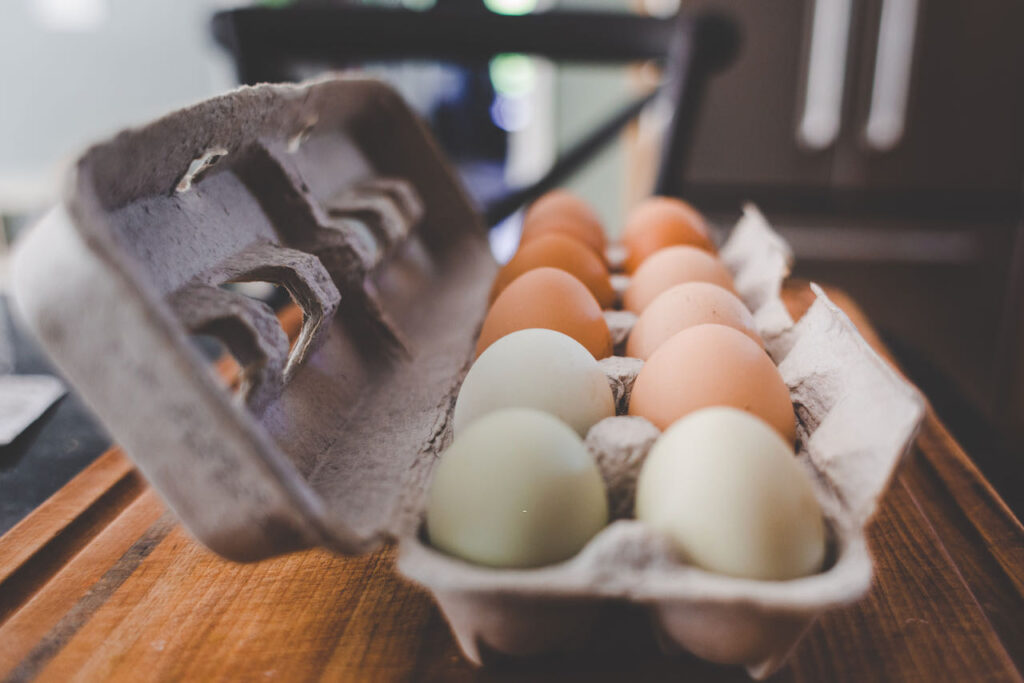
This entry was posted in Chickens


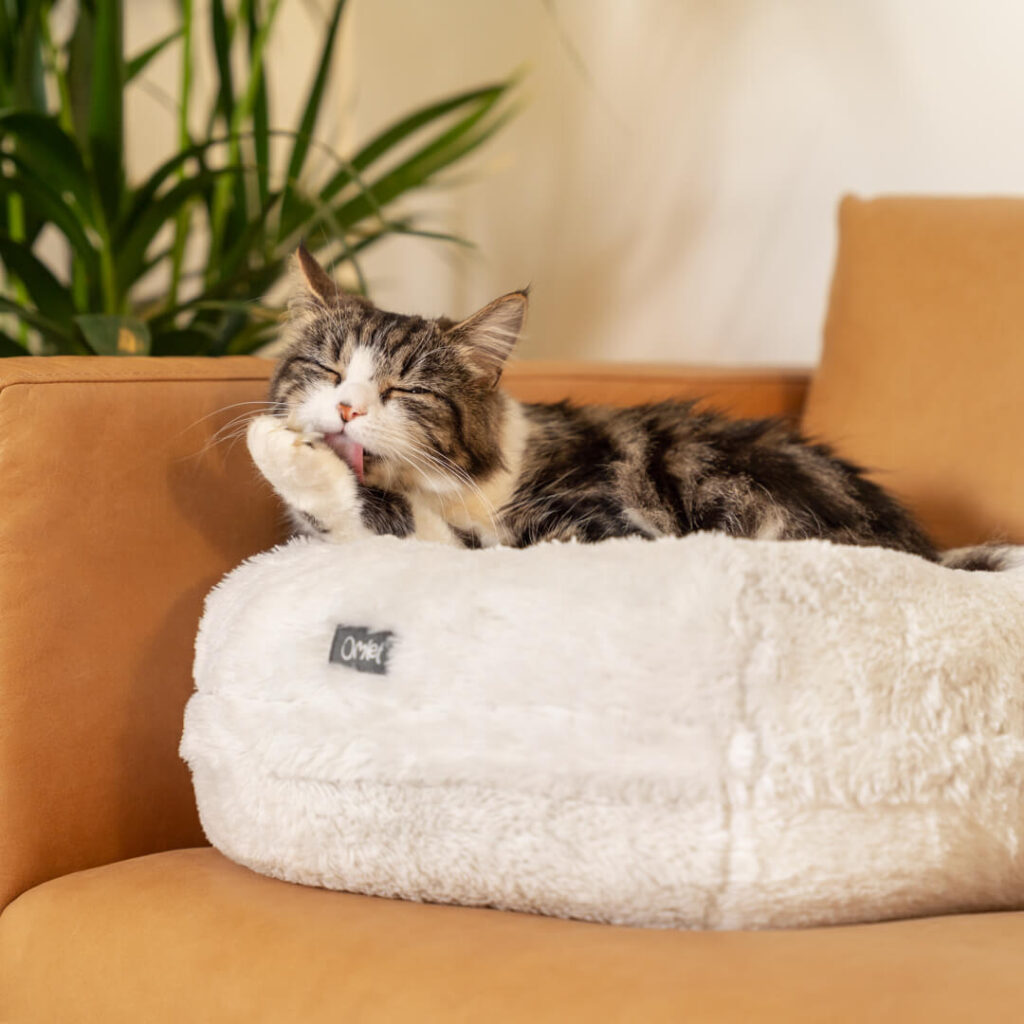

 Cats may like to sleep with their owner for warmth, company or reassurance, but it may also simply be because your bed is far better than theirs.
Cats may like to sleep with their owner for warmth, company or reassurance, but it may also simply be because your bed is far better than theirs. The first step to finding a bed your cat will actually use is identifying what they like; there is no use in buying a small cave bed if your cat prefers to stretch out across the sofa, or a thin, flat bed if your cat likes to sleep in a deep, squishy cushion. Ignore novelty cushions, get your cat a bed they will actually love.
The first step to finding a bed your cat will actually use is identifying what they like; there is no use in buying a small cave bed if your cat prefers to stretch out across the sofa, or a thin, flat bed if your cat likes to sleep in a deep, squishy cushion. Ignore novelty cushions, get your cat a bed they will actually love.












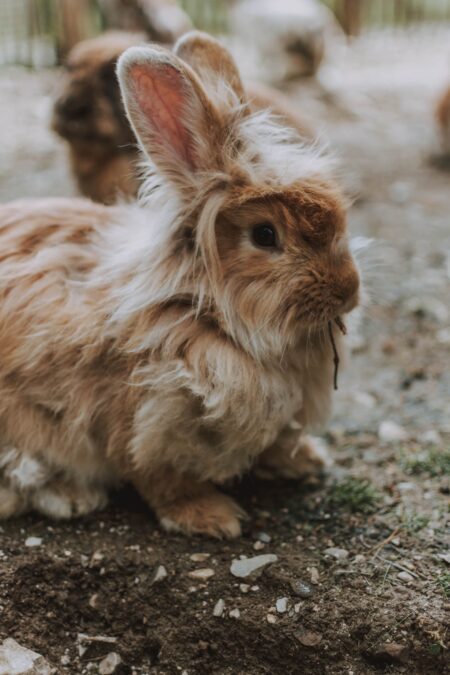
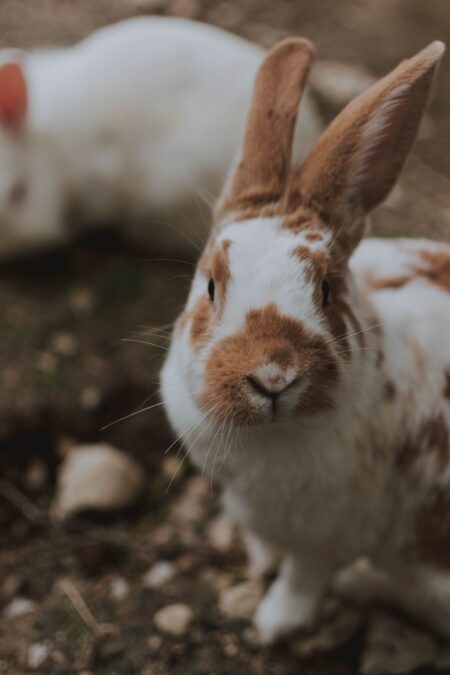



 Unfortunately, bullying amongst chickens happens, and isn’t actually too uncommon of a problem. Chickens naturally create a pecking order, whereby the flock will establish themselves in a social hierarchy of strongest to weakest chicken. However, if aggressive behavior continues after the head rooster, or the dominant hen in their absence, has found their way to the top of the ladder, you may be dealing with a bully. Common signs are missing feathers from a chicken’s back, unusual weight loss, reduced egg production, or blood from where the victim has been pecked, all of which could lead to a chicken/s refusing to go into their coop at night.
Unfortunately, bullying amongst chickens happens, and isn’t actually too uncommon of a problem. Chickens naturally create a pecking order, whereby the flock will establish themselves in a social hierarchy of strongest to weakest chicken. However, if aggressive behavior continues after the head rooster, or the dominant hen in their absence, has found their way to the top of the ladder, you may be dealing with a bully. Common signs are missing feathers from a chicken’s back, unusual weight loss, reduced egg production, or blood from where the victim has been pecked, all of which could lead to a chicken/s refusing to go into their coop at night.


 While these two critters do have things in common, their different habitats and ways of life mean that a hamster’s home setup is very different from that of a guinea pig.
While these two critters do have things in common, their different habitats and ways of life mean that a hamster’s home setup is very different from that of a guinea pig. The dietary requirements of hamsters and guinea pigs are probably the most significant difference between the two species. Hamsters are omnivorous and will eat pretty much anything they can find. They famously store food in their cheeks for later, making their cute faces puff up, almost doubling the animal’s size.
The dietary requirements of hamsters and guinea pigs are probably the most significant difference between the two species. Hamsters are omnivorous and will eat pretty much anything they can find. They famously store food in their cheeks for later, making their cute faces puff up, almost doubling the animal’s size.
 As the days get shorter, you might find that your chickens are not laying as much as they normally do. Egg production is partly regulated by daylight hours, and the more light the chickens see, the more eggs they will lay. Other factors that can affect the production are molting, broodiness and your hens getting older.
As the days get shorter, you might find that your chickens are not laying as much as they normally do. Egg production is partly regulated by daylight hours, and the more light the chickens see, the more eggs they will lay. Other factors that can affect the production are molting, broodiness and your hens getting older. 








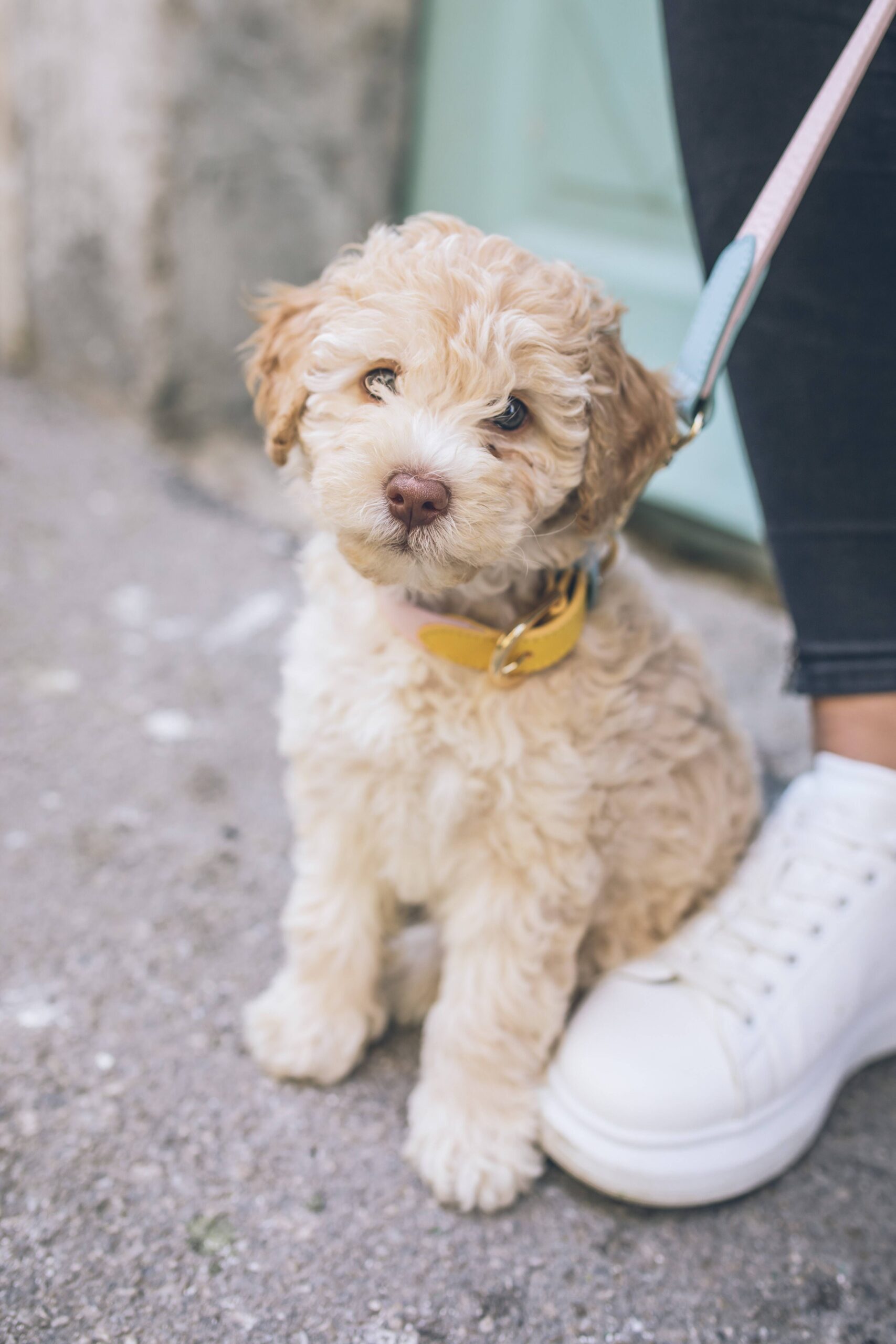
















 Chickens sometimes lay eggs that look nothing like a standard supermarket egg. Some are huge, some are tiny, some are ball-shaped, some are pointy, and some are soft-shelled. There are various reasons for these oddities.
Chickens sometimes lay eggs that look nothing like a standard supermarket egg. Some are huge, some are tiny, some are ball-shaped, some are pointy, and some are soft-shelled. There are various reasons for these oddities.
